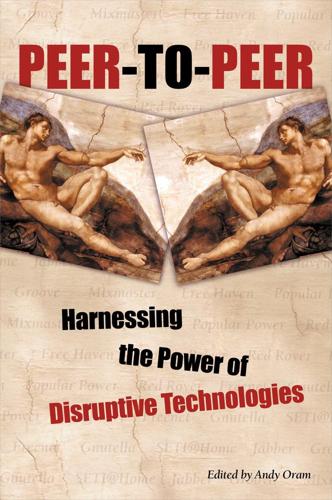
Peer-to-Peer
by
Andy Oram
Published 26 Feb 2001
Groove, Why secure email is a failure sandboxing, Sandboxing and wrappers Saudi Arabia and legal status of ISPs, Precedents and parries scalability, Performance Freenet and, Scalability Gnutella and, Scalability web of trust and, Codifying reputation on a wide scale: The PGP web of trust scale-free link distributions, Link distribution in Freenet Schmidt, Bob, Placing nodes on the network, Host caches Schmidt, Eric, File sharing: Napster and successors Schneier, Bruce, Cryptography fundamentals, Groove versus email scoring algorithms, Scoring algorithms–Scoring algorithms factoring credibility into, Credibility Free Haven, Reputation systems incorporating credibility into, Scoring algorithms Reputation Server, Reputation metrics–Reputation metrics treating reputations as probabilities, Scoring algorithms vs. privacy of transaction data, Privacy and information leaks scoring postings/posters on Slashdot, Who will moderate the moderators: Slashdot scoring systems, Scoring systems–True decentralization adversarial approach to, Scoring algorithms aspects of, Aspects of a scoring system attacks against, Attacks and adversaries, Attacks and adversaries bootstrapping, Bootstrapping collecting ratings, Collecting ratings confidence values and, Personalizing reputation searches decentralizing, Decentralizing the scoring system–True decentralization default reputation score, Bootstrapping detecting suspicious behavior, Scoring algorithms importance of user interface in, Personalizing reputation searches meta-reputation problem, Multiple trusted parties privacy/information leaks, Privacy and information leaks–Privacy and information leaks qualitative vs. quantitative information, Personalizing reputation searches qualities of good, Scoring systems Reputation Server, Identity as an element of reputation, Scoring system separating performance and credibility, Scoring algorithms timing attacks against privacy of, Privacy and information leaks true decentralization, True decentralization using multiple trusted parties, Multiple trusted parties using transactions to calculate ratings, Attacks and adversaries weighting a score, Reputation systems Scott, Tracy, Distributed intelligence SDMI (Secure Digital Music Initiative), Yesterday’s technology at tomorrow’s prices, two days late SDSI/SPKI (Simple Distributed Security Infrastructure/Simple Public Key Infrastructure), Codifying reputation on a wide scale: The PGP web of trust, Shared space formation and trusted authentication search algorithms and centralization, Decentralization search engines centralized vs. distributed, Trust and search engines–Distributed search engines problems with, Searching trust issues and, Trust and search engines–Deniability secret sharing algorithms, Anonymity for anonymous storage Publius, Secret sharing Secure Digital Music Initiative (SDMI), Yesterday’s technology at tomorrow’s prices, two days late Secure Sockets Layer (see SSL) security, Security–Taxonomy of Groove keys centralizing crucial aspects of, Central control and local autonomy–Central control and local autonomy collaboration and, Groove versus email email and, Groove versus email granular, distributed at workgroup level, Groove versus email guarantees made by Groove, Security Red Rover weaknesses and, Putting low-tech “weaknesses” into perspective–Putting low-tech “weaknesses” into perspective of reputation systems, Attacks and adversaries selecting favored users, Accountability Semantic Web, Resources and relationships: A historical overview SERENDIP project, Radio SETI server deniability, Anonymity for anonymous storage server software, Publius, Publius, Publish operation, Server software server volunteers, Denial of service attacks, Mojo Nation and Free Haven, Freenet server-anonymity, Anonymity for anonymous storage attacks on, Attacks on anonymity Eternity Usenet and, An analysis of anonymity Free Haven and, An analysis of anonymity Freenet and, An analysis of anonymity Gnutella and, An analysis of anonymity Publius and, An analysis of anonymity servers dormant, Introducers web (see web servers) servnet, Free Haven (see Free Haven, servnet) SETI@home, Some context and a definition, Maximizing use of far-flung resources: Distributed computation, SETI@home–The peer-to-peer paradigm client program of, How SETI@home works computations, How SETI@home works data distribution server, How SETI@home works detecting signals, How SETI@home works difficulties and challenges, Trials and tribulations drift rates and, How SETI@home works floating-point operations and, The world’s most powerful computer how it began, SETI@home–Radio SETI how it works, How SETI@home works–How SETI@home works peer-to-peer paradigm and, The peer-to-peer paradigm processor-specific optimizations, Trials and tribulations security challenges, Trials and tribulations SERENDIP and, How SETI@home works server performance problems, Trials and tribulations user interest in, Human factors world’s most powerful computer, The world’s most powerful computer SHA-1 hash function (Publius), Hash functions Shamir, Adi, Nonparallelizable work functions, Micropayment digital cash schemes Shamir’s secret sharing algorithm (Publius), Secret sharing, True decentralization shared databases, Ways to fill shared databases–Napster: Harnessing the power of personal selfishness shared spaces cryptographic algorithms, Security characteristics of a shared space email, Groove versus email weaknesses of, Why secure email is a failure–Why secure email is a failure forming, Shared space formation and trusted authentication–Shared space formation and trusted authentication Groove, Security, The solution: A Groove shared space inviting people into, Inviting people into shared spaces joining or leaving, Anatomy of a mutually-trusting shared space mutually-suspicious, Mutually-suspicious shared spaces–Fetching lost messages mutually-trusting, Mutually-trusting shared spaces–The key to mutual trust projecting identities into, Anatomy of a mutually-trusting shared space security characteristics of, Security characteristics of a shared space–Security characteristics of a shared space using a relay server for peer communication, Message fanout shares Free Haven expiration dates of, Share expiration splitting files into, Publication trading, The design of Free Haven, Trading Publius, System architecture, Publius in a nutshell protecting against update attacks, Using the Update mechanism to censor retrieving, Retrieve operation splitting the key into, Publish operation–Publish operation shilling, Attacks and adversaries categorizing reputations to defend against, Scoring algorithms tying feedback to transactions to avoid, Collecting ratings Shirky, Clay, Contents of this book, Listening to Napster–New winners and losers, Contributors Shostack, Adam, Communications channel signals, detecting (SETI@home), How SETI@home works Signature Verification Keys (SVKs), Signature Verification Keys (SVKs) signature/verification key pairs, Anatomy of a mutually-trusting shared space, Taxonomy of Groove keys signatures, digital (see digital signatures) Simon and Rackoff, Future work Simple Object Access Protocol (SOAP) and web services, Web services and content syndication Simple Symmetric Transport Protocol (SSTP), Message fanout simulating behavior over time Freenet, Initial experiments–Initial experiments Gnutella, Initial experiments–Initial experiments fault tolerance in a Freenet network, Simulating fault tolerance in Gnutella, Fault tolerance and link distribution in Gnutella growth, in a Freenet network, Simulating growth–Simulating growth Sipser, Michael, Open source software Slashdot effect, Freenet protecting against, Active caching and mirroring resource allocation and, Conclusion Slashdot moderation system, Who will moderate the moderators: Slashdot vs.
…
It costs $110 million, weighs 106 tons, and has a peak performance of 12.3 TFLOPS. SETI@home is faster than ASCI White, at less than 1% of the cost. The FFT computations for each SETI@home work unit require 3.1 trillion floating-point operations. In a typical day, SETI@home clients process about 700,000 work units. This works out to over 20 TFLOPS. It has cost about $500,000, plus another $200,000 or so in donated hardware, to develop SETI@home and operate it for a year. Of course, the cost of the one million PCs running SETI@home greatly exceeds that of ASCI White—but these PCs were bought and paid for before SETI@home and would exist even without it.
…
Graphic artists sent us dozens of banner and link graphics; one of these was so attractive that it replaced Gedye’s original planet-and-wave image (which he threw together in PowerPoint) as our logo. When it became clear that SETI@home was being widely embraced by the public, several questions arose. How was the word about SETI@home being spread? Why were people running SETI@home? Were they leaving their computers on longer, or buying faster computers, because of SETI@home? We’ve heard the following “viral marketing” scenario from many sources: one person in an office starts running SETI@home; people see the screensaver graphics, ask about it, hear the explanation of the project, and try it themselves. Soon the entire office is running it.

Smart Mobs: The Next Social Revolution
by
Howard Rheingold
Published 24 Dec 2011
That’s where community computing comes in. SETI@home participants install client software (a program they download from the Net and run on their home computer; the client communicates automatically with the central “server” computer in Berkeley). The client software downloads a small segment of radio telescope signals and processes it, looking for interesting patterns consistent with intelligent life. When the task is complete, the program uploads the results to SETI@home headquarters and collects a new chunk of digitized space signal to search. When the computer’s user logs into the machine, the SETI@home client goes dormant, awakening again when the human user pauses for more than a few minutes.
…
Reed, “That Sneaky Exponential,” 1999. Chapter 3 Epigraph: Cory Doctorow, “My Date with the Gnomes of San Jose,” Mindjack, 15 October 2000.http://www.mindjack.com/feature/p2p.html. (25 January 2002). 1. Charlene Anderson, “SETI@home and the Planetary Society: A Reminiscence and a Hope for the Future,” May 2000, <http://www.planetary.org/UPDATES/seti/seti@home_and_planetary_society.html > (20 January 2002). See also: Roving Mouse, “SETI@home Stats,” <http://www.roving-mouse.com/setiath-ome/> (25 January 2002). 2. Robert Wright, Nonzero: The Logic of Human Destiny (New York: Vintage, 2000). 3. David P. Reed, “That Sneaky Exponential: Beyond Metcalfe’s Law to the Power of Community Building,” Context Magazine, Spring 1999 (by permission of DiamondCluster International, Inc. © 1999) <http://www.contextmag.com/archives/199903/digitalstrategyreedslaw.asp > (1 February, 2002). 4.
…
Anderson, tall, dark-haired, with the lank and sinew of a long-distance runner, takes his time thinking about a response and then tends to speak in perfectly formed paragraphs. I asked him how SETI@home started. “In 1995,” Anderson recalled, “I was contacted by a former Berkeley grad student named David Gedye. Inspired by documentaries about the Apollo moon landing, an event that made people all over the world feel that human beings were taking a collective step forward, Gedye wondered what contemporary project today might have a similar impact and hit upon the idea of harnessing the public’s fascination with both the Internet and the SETI program.” In mid-1999, SETI@home clients were made available online for free downloading.
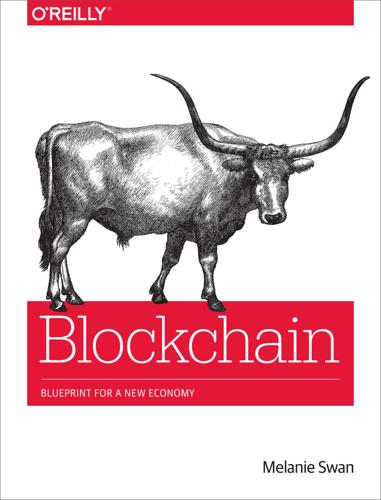
Blockchain: Blueprint for a New Economy
by
Melanie Swan
Published 22 Jan 2014
So far, the main thread is related to peer-to-peer distributed computing projects for which individual volunteers provide unused computing cycles to Internet-based distributed computing projects. Two notable projects are SETI@home (the Search for Extraterrestrial Intelligence, which uses contributed computing cycles to help analyze radio signals from space, searching for signs of extraterrestrial intelligence), and Folding@home (a Stanford University project for which computing cycles are used to simulate protein folding, for computational drug design and other molecular dynamics problems). Per blockchain technology, remunerative coin has been set up to reward participants in both the SETI@home and Folding@home projects. For SETI@home, there is Gridcoin, which is the remunerative coin available to all BOINC (Berkeley Open Infrastructure for Network Computing) projects, the infrastructure upon which SETI@home runs.
…
There are two apps, DriveShare and MetaDisk, which respectively enable users to rent out their unused hard disk space and store their files on the Storj network. Purported methods for safely sharing unused hard disk space have been developed by other community computing models like Folding@Home and BOINC, whose software is used by SETI@Home. Of course, as with any distributed project that involves opening your computer to others’ use, caveat emptor applies, and participants in Storj or any similar project should satisfactorily inform themselves of the security details. Storj’s altcoin token, Storjcoin X (SJCX), is a cryptocurrency that runs on the Counterparty protocol.
…
For SETI@home, there is Gridcoin, which is the remunerative coin available to all BOINC (Berkeley Open Infrastructure for Network Computing) projects, the infrastructure upon which SETI@home runs. For Folding@home, there is FoldingCoin, a Counterparty token that runs and is exchangeable to the more liquid XCP cryptocurrency (and therefore out to Bitcoin and fiat currency) via the Counterparty wallet (Counterwallet). A more fundamental use of the blockchain for science could be addressing the wastefulness of the mining network, which consumes massive amounts of electricity. Instead of being used to crunch arbitrary numbers, perhaps the extensive processing power could be applied to the more practical task of solving existing science problems.
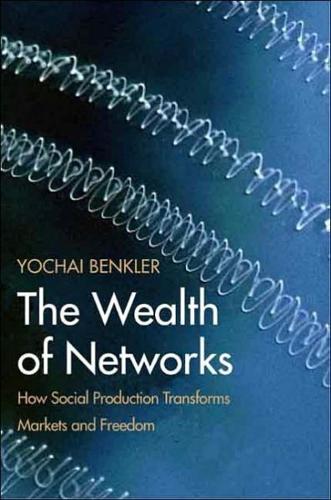
The Wealth of Networks: How Social Production Transforms Markets and Freedom
by
Yochai Benkler
Published 14 May 2006
The participants are, instead, sharing material goods that they privately own, mostly personal computers and their components. They produce economic, not public, goods--computation, storage, and communications capacity. 168 As of the middle of 2004, the fastest supercomputer in the world was SETI@home. It ran about 75 percent faster than the supercomputer that [pg 82] was then formally known as "the fastest supercomputer in the world": the IBM Blue Gene/L. And yet, there was and is no single SETI@home computer. Instead, the SETI@home project has developed software and a collaboration platform that have enabled millions of participants to pool their computation resources into a single powerful computer. Every user who participates in the project must download a small screen saver.
…
As of the middle of 2004, the project had harnessed the computers of 4.5 million users, allowing it to run computations at speeds greater than those achieved by the fastest supercomputers in the world that private firms, using full-time engineers, developed for the largest and best-funded government laboratories in the world. SETI@home is the most prominent, but is only one among dozens of similarly structured Internet-based distributed computing platforms. Another, whose structure has been the subject of the most extensive formal analysis by its creators, is Folding@home. As of mid-2004, Folding@home had amassed contributions of about 840,000 processors contributed by more than 365,000 users. 169 SETI@home and Folding@home provide a good basis for describing the fairly common characteristics of Internet-based distributed computation projects.
…
Why can fifty thousand volunteers successfully coauthor Wikipedia, the most serious online alternative to the Encyclopedia Britannica, and then turn around and give it away for free? Why do 4.5 million volunteers contribute their leftover computer cycles to create the most powerful supercomputer on Earth, SETI@Home? Without a broadly accepted analytic model to explain these phenomena, we tend to treat them as curiosities, perhaps transient fads, possibly of significance in one market segment or another. We [pg 6] should try instead to see them for what they are: a new mode of production emerging in the middle of the most advanced economies in the world-- those that are the most fully computer networked and for which information goods and services have come to occupy the highest-valued roles. 21 Human beings are, and always have been, diversely motivated beings.
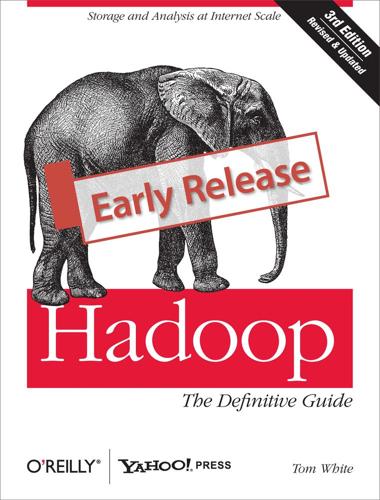
Hadoop: The Definitive Guide
by
Tom White
Published 29 May 2009
You can see a sample of some of the applications that Hadoop has been used for in Chapter 16. Volunteer Computing When people first hear about Hadoop and MapReduce, they often ask, “How is it different from SETI@home?” SETI, the Search for Extra-Terrestrial Intelligence, runs a project called SETI@home in which volunteers donate CPU time from their otherwise idle computers to analyze radio telescope data for signs of intelligent life outside earth. SETI@home is the most well-known of many volunteer computing projects; others include the Great Internet Mersenne Prime Search (to search for large prime numbers) and Folding@home (to understand protein folding and how it relates to disease).
…
Volunteer computing projects work by breaking the problem they are trying to solve into chunks called work units, which are sent to computers around the world to be analyzed. For example, a SETI@home work unit is about 0.35 MB of radio telescope data, and takes hours or days to analyze on a typical home computer. When the analysis is completed, the results are sent back to the server, and the client gets another work unit. As a precaution to combat cheating, each work unit is sent to three different machines and needs at least two results to agree to be accepted. Although SETI@home may be superficially similar to MapReduce (breaking a problem into independent pieces to be worked on in parallel), there are some significant differences. The SETI@home problem is very CPU-intensive, which makes it suitable for running on hundreds of thousands of computers across the world,[9] since the time to transfer the work unit is dwarfed by the time to run the computation on it.
…
id=70001. [8] Apache Mahout (http://mahout.apache.org/) is a project to build machine learning libraries (such as classification and clustering algorithms) that run on Hadoop. [9] In January 2008, SETI@home was reported at http://www.planetary.org/programs/projects/setiathome/setiathome_20080115.html to be processing 300 gigabytes a day, using 320,000 computers (most of which are not dedicated to SETI@home; they are used for other things, too). A Brief History of Hadoop Hadoop was created by Doug Cutting, the creator of Apache Lucene, the widely used text search library. Hadoop has its origins in Apache Nutch, an open source web search engine, itself a part of the Lucene project.
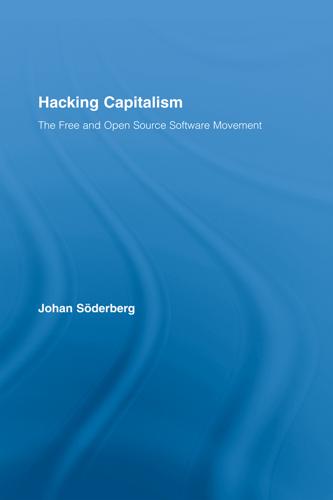
Hacking Capitalism
by
Söderberg, Johan; Söderberg, Johan;
That could be the deeper implication of the SETI@home project. SETI@home is a favourite example in hacker literature, mingling high technology with fascination for science fiction. SETI stands for: Search for Extraterrestrial Intelligence. SETI searches for intelligent alien life by scanning for radio signals from outer space. The huge task of analysing the data received is distributed to volunteers who lend spare capacity on their personal computers. For a succession of years the project has out-performed state-of-the-art supercomputers at a fraction of the cost.21 The SETI@home project is not as dramatic as the controversies surrounding filesharing networks, nor does it have the zeal of grassroots journalism.
…
McCaughey & Ayers, Cyberactivism—Online Activism in Theory and Practice (New York: Routledge, 2003), Dan Gillmore, We the Media—Grassroots Journalism—By the People, For the People (Cebastopol C.A.; O’Reilly, 2006). 20. Eben Moglen, “Anarchism Triumphant, Free Software and the Death of Copyright”, First Monday, vol.4, no.8 (August 1999). 21. See David Anderson, “SETI@home” in Andy Oram, Peer-to-Peer—Harnessing the Benefits of a Disruptive Technology, (Sebastopol: O’Reilly, 2001), 2001. 22. Mark Poster, What’s the Matter With the Internet? (Minneapolis: University of Minnesota Press, 2001), 97. 23. www.nature.com/news/2005/051212/full/438900a.html, (accessed 2007-02-08). 24. http://alumni.media.mit.edu/~fviegas/papers/history_flow.pdf, (accessed 2007-02-08). 25.
…
Index Aestethic innovation 64, 68, 177 Adorno, Theodor 65, 70, 168, 191–192 Advanced Research Projects Agency, see ARPA Affluent society 99–101 Aglietta, Michel 59 Alienation 10, 156–159, 173, 182, 188, 190 Allopoietic 134–135 Altair 17 Althusser, Louis 77 Analytical Engine 3 Anti-production 120, 213 n.12 AOL Time Warner 89, 91, 125 Apache 24, 28, 38, 44 Apple 17 ARPA (advanced research projects agency) 13–15 AT&T (american telephone and telegraph) 13–15, 19, 23–24, 91, 116 Audience power 66, 68, 198 n.47, 204 n.40 Authorship 74, 78, 80–82, 112, 114, 125, 128–129, 138, 154, 160, 174, 206 n.9 Autonomous Marxism 6–7, 52, 55, 176, 194 n.18, 201 n.9 Autopoietic 134–135, 155 Axelos, Kostas 158–159 Babbage, Charles 3–4 Back Orifice 80 Barbrook, Richard 150, 216 n.27 Bataille, George 147, 149, 154, 216 n.20 Baudrillard, Jean 64, 103, 105, 109, 127, 202 n.19, 211 n.9, n.12 BBS (bulletin board systems) 96 Beauty of the Baud 3, 184 Bell, Daniel 51, 54, 100, 170–171, 173 Bell, Graham 11 Bell laboratory 14 Benjamin, Walter 65, 207 n.18, 210 n.49 Benkler, Yochai 139–140, Berkeley internet name domain, see BIND Berkeley software distribution, see BSD Berne convention 85, 208 n.25 Bertelsmann 124 Biegel, Stuart 91 Bijker, Wiebe 54–55, 203 n.24 Binary code 19, 21–22, 97, 195 n.16 BIND (Berkeley internet name domain) 25 Biometric technology 92–93 Black, Edwin 194 n.15 Boomerang externalities 146 Bowles, Samuel 173 Boyle, James 117, 208 n.24 Brand, Stewart 16, 69 Braverman, Harry 130–133 British cultural studies 9, 65–66 Brooks, Fred 184 BSD (Berkeley software distribution) 15, 23–24, 38 Bulletin board systems, see BBS Burghardt, Gordon 166–167 Bush, Vannevar 12 Caffentzis, George 61–63 Caillois, Roger 166–167, 182 Castells, Manuel 51, 145, 200 n.3, 202 n.19, 216 n.15 CC (Creative commons) 4, 41, 78 Censorship 4, 79–80, 82, 91, 97, 178, 189 CERN (Conseil européen pour la recherche nucléaire) 25 Certeau, Michel de 66, 112, 182 Chaos computer club 180 Charismatic code 153, 217 n.33 Chiapello, Eve 163 Circulating capital 120, 145 Class consciousness 18, 178, 180–181 for-itself 188 struggle 4, 7, 44, 47–48, 54, 56, 67, 72, 76, 103–104, 159, 175–178, 188, 203 n.20, 204 n.27, 212 n.12 Clickwrap license, see shrinkwrap license Coase, Ronald 140 Cohen, Gerald 54 Collective invention, 213 n.6 Collins, Hugh 76–77 Commodification of information 8, 31, 199 n.60, Commodity exchange theory 75–76, 90 Commons 119, 122, 129, 135, 137, 145–148, 150–151, 171–172, 184, 191, 199 n.57, 216 n.18 Community for-itself 183 FOSS developers 21, 23 Compiling 195 n.16 Computer literacy 131–132 Constant capital 127 Copyleft 20–22, 34, 196 n.19, n.21, 198 n.44 Copyright law 8, 18–22, 78–79, 82–85, 94, 98, 112, 113, 143, 154, 181, 195 n.14, 196 n.19, 207 n.15, 208 n.22 Crackers 69, 98, 113, 151, 153, 155, 183, 188, 217 n.35 Creative class 51, 61, 173–174 Creative commons, see CC Cross, Gary 101 Cultural workers 82, 163–164, 192 Culture industry 57, 70, 73, 75, 85, 106, 112, 168, 173, 205 n.46 Cyber attacks 199 n.61 feminism 30, 214 n.32 libertarianism 4, 90, 216 n.27 marx 52 politics 4, 30, 48, 69 space 11, 88, 150 Cycles of struggle 176–177 Cygnus 32–34 Darknet 97 Davies, Donald 195 n.5 Debian 123 Debian-women 30 Debord, Guy 103, 211 n.9 Decompiling 195 n.16 DeCSS see DVD-Jon Deleuze, Gilles 135, 213 n.12, 215 n.34 Denial-of-service attacks 1, 193 n.3 Derrida, Jacques 57, 149, 153, 216 n.24 Desire 18, 27, 48, 105, 109, 136, 155–156, 161, 174, 185–186 Deskilling 5, 9, 45, 97, 111, 130–131, 209 n.44, 210 n.56 Desktop factory 186 Developing countries and FOSS 30, 87, 96, 210 n.54 Difference Engine 3 Digital rigths management, see DRM DRM (digital rights management) 22, 42, 91, 183, 209 n.45 DVD-Jon 87–88, 91 Edelman, Bernard 77–78, 80, 207 n.16 Edwards, Richard 89 Electro-hippies 178 Electronic Frontier Foundation 58, 208 n.21 Ellickson, Robert 217 n.30 Empire 6 Enclosure movement 71, 129, 171 Engels, Friedrich 53, 115 Enzensberger, Hans 194 n.16, 210 n.49 Excess of expenditure 49, 100, 136, 147–148, 153–155, 171, 174 Exchange value 45, 56, 103–105, 109, 144, 211 n.12 Fan media production 112–113, 127, 164, 183, 191, 212 n.20, 194 n.16 Fanning, Shawn 124–125 Felsenstein, Lee 17 Filesharing networks 4, 8, 10, 31, 73, 93–94, 113, 127, 137, 150–153, 189 Firefox 37, Fisher, William 74–75 Fixed capital 15, 27, 39, 68 Flextronics 96 Florida, Richard 51, 173–174 Fordism 59, 67, 101, 203 n.26 Formal subsumption 56, 118 FOSS (free and open source) community 5, 8, 28–29, 38, 49, 111, 125, 133, 172, 177 development model 6, 9, 24, 41, 49, 115, 121, 137, 139–140, 190 license 8, 20, 28, 40, 78, 122, 125, 190 movement 26–27, 31–32, 38, 43, 50, 116, 133, 150, 184, 195 n.17 Foucault, Michel 48, 57, 76, 80, 128, 181 Frankel, Justin 124–125 Frankfurt School 57, 160 Free and open source software, see FOSS Freenet 80, 214 n.18, Free software foundation 19, 22–23, 37, 73, 126, 179–180, 196 n.20, n.23 movement 151, 195 n.17 Free speach not free beer 32, 73, 123 French regulation school 59, 204 n.27 French revolution 1–2, 79, 159, 161, 165, 187 Friedman, Andrew 133 Frow, John 151 Gaines, Jane 207 n.20 Garnham, Nicholas 102 Gates, Bill 4 Gay, Paul du 106–107 General economy 147 intellect 60, 63, 184 public license, see GPL Giddens, Anthony 200 n.6 Gift economy 10, 54, 100, 137, 148–152 Gintis, Herbert 173 Gnome 35, GNU (GNU is not Unix) book 210 n.55 Emacs 20, 32 /Linux 4, 15, 22–24, 26, 28, 31–35, 38–39, 43–44, 47, 87, 123, 163, 183, 196 n.23, n.28 Gnutella 124–125, 153, 214 n.18 Google 41 Gopher 25 Gosling, James 20 Gouldner, Alvin 201 n.12 GPL (General public license) 19–24, 27, 31–32, 34–35, 37, 96, 129, 185, 196 n.19, n.20, n.21, 197 n.44 Gracenote 41, 199 n.57 Guattari, Felix 135, 213 n.12, 215 n.34 Habermas, Jurgen 202 n.16 Hacker manifesto 28, 30, 172 spirit 44, 108, 174, 199 n.66 Hacktivists 16, 55, 84, 178, 180, 182 Haeksen 30, 197 n.41 Halloween Documents 26 Haraway, Donna 197 n.42 Hardin, Garrett 145–146, 148 Hardt, Michael 6, 47–48, 52, 60, 194 n.18, 204 n.30 Hardware hackers 7, 17–18, 96 Harrison, Bennett 140–141 Harvey, David 95 Haug, Wolfgang 104–105 Hayes, Dennis 44 Hayles, Katherine 71–72, 203 n.22 Hearn, Francis 168, 182 Heeles, Paul 108 Hegel, G.W.F. 52–53, 56, 74, 157 Heidegger, Martin 160 Heller, Michael 148 High-tech cottage industry 139 gift economy 10, 100, 137, 150 Himanen, Pekka 100, 108, 174, 199 n.66 Hippel, Eric von 205 n.44 Hirsch, Fred 102, 171 Hobsbawm, Eric 76, 189, 193 n.6 Holloway, John 7 Homebrew computer club 17, 185 Homo ludens 165 Horkheimer, Max 65, 70, 168 Howard, Michael 114–115 Huizinga, Johan 165–167, 182 Human genome project 39, 93 Hyde, Lewis 152, IBM 5, 7, 17–19, 24, 38, 43–44, 47, 73, 92, 108, 128, 142, 194 n.15 Identification 90–93, 189 Identity 98, 110, 123, 174–177, 181 Illich, Ivan 128, Immaterial labour 52, 60–61, 71 Independent media centre (IMC) 126 Information age 8, 19, 31, 50–54, 57, 60, 108, 180, 182, 199 n.66, 202 n.19, 203 n.26 exeptionalism 69–70, 73, 132, society 50 Instrumentality 10, 49, 56, 116, 160, Intel 17, 38–39, 43, 92, 198 n.52 Intellectual property enforcement 5, 43, 83, 85, 85, 88, 94, 98, 133 regime 19, 35, 42, 65, 72–75, 80, 82–85, 111, 113–114, 119, 123, 154, 174 Internet explorer 36–37 Jacquard Joseph-Marie 1, 3 Jacquard loom, 1, 193 n.1, n.2, n.4 Jameson, Fredric 56, 64, 201 n.8, 202 n.17 Jefferson, Thomas 69, 205 n.50 Jenkins, Henry 212 n.20 Jessop, Bob 143, 216 n.14 Johansen, Jon, see DVD-Jon Johnson-Forrest Tendency 143 Kant, Immanuel 74, 161 Kautsky, Karl 53–54 KDE (K desktop environment) 35 Kenney, Martin 39, 67 Keynesianism 143, 170 King, John 114–115 Kirchheimer Otto 77 Kloppenburg, Jack 90 Kopytoff, Igor 150 Kropotkin, Peter 129 Labour contract of the outlaw 123 Laclau, Ernesto 175 Lamer 58, 153, 155 Landsat system 119 Late capitalism 56, 101, 104, 120, 168, 188, 201 n.8, 202 n.17, n.18 Lazzarato, Maurizio 60–62 Lenin, Vladimir 4, 115 Lessig, Lawrence 70, 88 Lévi-Strauss, Claude 152, 217 n.34 Levy, Steven 17 Libertarianism 18, 34, 50, 90, 182, 196 n.28, 216 n.27 Library economy 136, 151–153, 155 Liebowitz, Stan 122–123, 144, Linux, see also GNU/Linux chix 30 kernel 21, 23, 49, 193 n.7, 196 n.23 Liu, Alan 48 Locke, John 74, 78, 147, 154 Luddites 1–2, 189 Lukács, Georg 162, 178–181, 184 Lury, Celia 81 Lyotard, Jean-Francois 201 n.10 Machlup, Fritz 69, 206 n.58 Magic circle 165, 167, 190 Make-believe markets 145–146, 148, 155 Mallet, Serge 60, 204 n.29 Malinowski, Bonislaw 148 Mandel, Ernest 56, 59–60, 62–63, 184, 202 n.17, n.18, n.19 Marconi Wireless Telegraph Company 116 Marcuse, Herbert 3, 10, 116, 159–164, 182, 184 Marx, Karl 2, 4, 7, 48, 50, 53–54, 56–57, 60–61, 64, 81, 88, 101, 104, 109–111, 114–115, 118–119, 133, 139, 141, 144–145, 156–162, 173–175, 197 n.32, 201 n.12, 211 n.5, 212 n.19, 215 n.4 Maslow, Abraham 99–101, 211 n.2 Mass worker 7, 176 Maturana, Humberto 134, 136s Mauss, Marcel 148–149 McBride, Darl 31, 87 McLuhan, Marshall 58 McRobbie, Angela 108 Means of production 9, 48, 57, 81, 116, 129–130, 135, 186, 192 Mentor, the 172 Micro-capital 141 Microsoft 4, 19, 24, 26, 34, 36–39, 42–43, 63, 87, 92, 96, 144 Mill, John Stuart 69 Minitel 14 Minix 23–24 Moglen, Eben 4, 126 Mokyr, Joel 55 Moody, Glen 35, 37, 130 Moore, Fred 17 Morris-Suzuki, Tessa 63–64 Mosaic 36, 198 n.50 Mosco, Vincent, 204 n.40 Motion pictures association of america, see MPAA Mouffe, Chantal 175 Mozilla 36–37, 198 n.50 Mozilla crypto group 126 MPAA (motion pictures association of america) 42, 87–88, 199 n.58, 209 n.36 Multitude 6–7, 60, 181 Mumford, Lewis 134, 147 Naples, Nancy 200 n.77 Napster 124–125, 213 n.17 Naughton, John 12, 15 N/C technology 45–46, 131 Negri, Antonio 6–7, 47–48, 52, 56–57, 60–61, 176–177, 194 n.18, 201 n.9, n.15, 202 n.16, 204 n.31, n.33 Neo-Luddism 134 Netscape 36–38, 126 Network externalities 38, 144 firm 137, 141–142, 144 industry 27, 137 science 141, 215 n.2 society 51, 137, 142 Neuman, Franz 77 Neumann, John von 61, 63 New economy 124, 132, 144 New left 16–17, 150–151, 157, 212 n.12 Noble, David 45, 131, 206 n.59 Norton, Bruce 202 n.17 Nullsoft 125 Nupedia 128 Oekonux 5 Offe, Claus 214 n.30 Office despotism 18 Opencores project 96 Open marxism 7 Open source car 185 development labs 43 initiative 36, 38–41, 78, 180 Organised labour 27, 41, 69, 72, 95–96, 131–132, 141–142, 188, 190 Pashukanis, Evgeny 75–77, 206 n.2 Patent costs 116–118 expansion 22, 39, 83–84, 208 n.24 pools 119 Peer-to-peer filesharing networks 31, 91, 123– 125, 151 labour relations 123, 129 Perelman, Michael 86, 171 Perpetual innovation economy 64, 120 Petty commodity trader 61, 81, 159 PGP (pretty good privacy) 80 Phone phreaks 16, 96–97 Pirate sharing 69, 122–123, 183, 209 n.33, n.45 Play drive 10, 18, 49, 154, 161–162 struggle 3, 10, 156, 174, 182, 190–192 Political subject 156, 174 Poster, Mark 128 Post- fordism 8, 59–61, 67, 81, 107, 116, 133, 135, 139–140, 163, 168, 176, 183, 203 n.26, 204 n.27 industrialism 5, 51–52, 54, 56, 60–61, 71, 100, 103, 130, 137, 139 marxism 175, 177 modern capitalism, 52, 56, 61, 64, 73, 101, 104, 120, 145, 168, 175–176, 188, 216 n.20 Poulantzas, Nicos 218 n.18 Pretty good privacy, see PGP Professional worker 176 Proprietary software 9, 16, 19, 21, 24, 26–27, 33–34, 38, 41, 115, 129–130, 139, 144, 198 n.46, n.52, 200 n.71 Prosumer 106–108 Put to work 8, 48, 73, 82, 177, 184 Qt 35 Radio amateur 17, 96, 185, 191 Radio frequency identifiers, see RFID RAND (research and development) 13 Rand, Ayn 206 n.61 Raymond, Eric 25–27, 196 n.28, 197 n.29 Real subsumption 56, 118, 135 Record industry association of america, see RIAA Recuperation 49, 164, 182 Red Hat 26, 32–35, 43, 47, 68, 196 n.27, 197 n.33, n.44, 198 n.45 Refusal of work 44, 108 Rehn, Alf 217 n.35 Representation politics 66, 110, 191 Research and development, see RAND Restrictive economy, see general economy RFID (radio frequency identifiers) 92 RIAA (record industry association of america) 42, 124–125, 153, 199 n.58 Robins, Kevin 194 n.17, 209 n.44 Romanticism 2, 81–82, 159, 162–163 Ross, Andrew 46, 199 n.66 Sabotage 1, 10, 46, 111, 188, 193 n.6 Sahlins, Marshall 70 Sanger, Larry 128 Sarnoff law 66 Scarcity 70–71, 99–101, 109, 112–113, 130, 147, 155, 160, 169, 190 Schiller, Dan 71, Schiller, Friedrich 23, 10, 154, 160–163, 184 Schumpeterian competition state 143 Schumpeter, Joseph 30 SCO/Caldera 43–44, 87 Self-administrated poverty 172 Sennett, Richard 45 SETI@home 127 Sham property 141 Shiva, Vandana 209 n.45 Shrinkwrap license 21 Shy, Oz 122, 143–144 Silicon Valley 44, 180 Simputer 210 n.54 Sitecom Germany GmbH 22 Situationists 150 Smythe, Dallas 66–67 Social bandit 76, 93–94, 98, 189 division of labour 4, 77, 99, 123, 149, 158–159, 164, 174, 187–188, 192, 205 n.44, 210 n.49 factory 47–48, 56, 64, 68, 89, 177 labour 38, 56, 71 planning theory 74–75 taylorism 90, 97–98, 209 n.44 worker 7, 60, 176–177 Sony 42 Stallman, Richard 19–20, 32, 37, 73, 179, 195 n.17, 196 n.23, 200 n.71 Strahilevitz, Jacob 152–153, 217 n.33 Stefik, Mark 92 Sterling, Bruce 11, 15 Strahilevitz, Jacob 152–153, 217 n.33 Surplus labour 8, 47–48, 61, 63, 67, 211 n.5 profit business model 34, 68 value 33–34, 47, 50, 61–64, 66–68, 101, 105, 110–111, 118, 120–121, 134, 156, 202 n.16, 204 n.40, 213 n.12, Surveillance 4–5, 85, 90–91, 97, 143, 145, 189, 214 n.18, Tanenbaum, Andrew 23 Taylorism 8, 45–46, 48, 90, 115, 132 Techies 16, 18, 30, 178, 182 Technical division of labour 27, 48, 115, 123, 132, 142, 155, 199 n.68 Technicist 54, 201 n.6 Technological american party 16, 18 Technological determinism 57–58, 182 Terranova, Tiziana 68 Toffler, Alvin 51, 106 Torvalds, Linus 21–23, 26–27, 49, 193 n.7, 197 n.32 Travis, Hannibal 207 n.15 TRIPS 86, 208 n.29 Troll Tech 35 Tronti, Mario 47 Trusted computing 92, 96 Unix 14–15, 19–20, 23–24, 43, 87, 195 n.7 User centred development 9, 27, 41, 65–68, 129, 131, 133, 192, 205 n.44 community 50, 68, 111, 123 friendliness 17, 45, 90, 98 Use value 68, 71, 101–105, 109, 113, 120, 122, 129, 144, 147, 153, 155, 211 n.9, n.12 Vaneigem Raoul 212 n.21 Varela, Francisco 134, 136 Variable capital 127 Veblen, Torsten 211 n.7 Villanueva, Edgar 144 Virno, Paulo 57, 73, 172, 177 Virtual community 152–153, 217 n.30 space 90, 92–93, 95, 184, 203 n.22, 217 n.33 Volosinov, Valentin 202 n.20 Voluntarism 5, 29, 179 Voluntary labour 2, 8, 107, 129, 166 Wales, Jimmy 128 Warez 153, 183, 217 n.35 Wark, McKenzie 177 W.a.s.t.e. 125 Watt, Duncan 141–142 Watt, James 166 Watt, Richard 213 n.14 Wayner, Peter 151–152 Webster, Frank 194 n.17, 200 n.3, 201 n.7, 209 n.44 Wetware 133–135 White collar working class 48, 97, 130, 200 n.72 hat hacking 180 Whole Earth Catalog 16 Wiener, Norbert 12 Wikipedia 128–129 Williams, Raymond 58 Windows 25, 41, 43, 86–87, 123, 126, 163, 183 Winner, Langdon 16, 203 n.25 WIPO (World Intellectual Property Organisation) 18, 83, 91 Wired Magazine 18, 58, 180 Witheford, Nick-Dyer 51, 204 n.31 Wolfgang, Haug 104–105 Wolf, Naomi 105 Wood, Stephen 131 Workfare state 135, 171 World Intellectual Property Organisation, see WIPO World Trade Organisation, see WTO Worshipful Company of Stationers London 79 Wright, Steve 201 n.9 WTO (World Trade Organisation) 86, 126, 178 Yahoo 41 Young, Robert 26–27, 33, 126, 196 n.27, 198 n.46, n.52 Youth international party line 16 Zero work 49 Zizek, Slavoj 4, 175

The Future of the Internet: And How to Stop It
by
Jonathan Zittrain
Published 27 May 2009
Our work is built on the belief that technological innovation combined with visionary scientific research and large-scale volunteerism can change our world for the better.”). The site makes it easy to become involved: “Donate the time your computer is turned on, but is idle, to projects that benefit humanity!” Id. 59. See SETI@home, http://setiathome.berkeley.edu (last visited Dec. 1, 2007); see also Wikipedia, SETI@home, http://en.wikipedia.org/wiki/Seti_at_home (as of May 12, 2007, 02:06 GMT). 60. BitTorrent allows many people to download the same file without slowing down everyone else’s download. This is possible because downloaders swap portions of the file with one another, instead of downloading it all from a single server.
…
A variety of programs already allow users to contribute idle CPU time to far-flung projects. See, e.g., Climateprediction.net, http://climateprediction.net/ (last visited June 1, 2007); Rosetta@home, What is Rosetta@home?, http://boinc.bakerlab.org/rosetta/rah_about.php (last visited June 1, 2007); SETI@home, The Science of SETI@home, http://setiathome.berkeley.edu/sah_about.php (last visited June 1, 2007); World Community Grid, About Us, http://www.worldcommunitygrid.org/about_us/viewAboutUs.do (last visited June 1, 2007). 115. Christopher Lawton, ‘Dumb Terminals’ Can Be a Smart Move, WALL ST. J., Jan. 30, 2007, at B3, available at http://online.wsj.com/public/article/SB117011971274291861-oJ6FWrnA8NMPfMXw3vBILth1EiE_20080129.html?
…
An information technology ecosystem comprising only the products of the free software movement would be much less usable by the public at large than one in which big firms help sand off rough edges.56 GNU/Linux has become user-friendly thanks to firms that package and sell copies, even if they cannot claim proprietary ownership in the software itself, and tedious tasks that improve ease of mastery for the uninitiated might best be done through corporate models: creating smooth installation engines, extensive help guides, and other handholding for what otherwise might be an off-putting technical piece of PC software or Web service.57 As the Internet and the PC merge into a grid, people can increasingly lend or barter computing cycles or bandwidth for causes they care about by simply installing a small piece of software.58 This could be something like SETI@home, through which astronomers can distribute voluminous data from radio telescopes to individual PCs,59 which then look for patterns that might indicate the presence of intelligent life, or it could be a simple sharing of bandwidth through mechanisms such as amateur-coded (and conceived, and designed) BitTorrent,60 by which large files are shared among individuals as they download them, making it possible for users to achieve very rapid downloads by accumulating bits of files from multiple sources, all while serving as sources themselves.

What's Mine Is Yours: How Collaborative Consumption Is Changing the Way We Live
by
Rachel Botsman
and
Roo Rogers
Published 2 Jan 2010
NASA has turned the project into a game where you earn points for “being a mapmaker” or “counting impact craters.” As these projects are voluntary, they attract only participants passionate about the subject and motivated to engage with a group of people to help solve real challenges. The same principle applies to SETI@home, which stands for “Search for Extraterrestrial Intelligence,” set up in 1999 by Space Sciences Laboratory at the University of California, Berkeley. In the essay “Sharing Nicely,” Yale Law School Professor Yochai Benkler pointed to the world’s largest distributed computer network to highlight the trend toward sharing and to prove the potential of a distributed network.
…
To date 5.2 million global volunteers have downloaded a small screensaver that identifies when their home computer is idle. At that time the computer is networked, and groups collaboratively download problems to calculate. When the problem is solved, the computer sends the results back to the main terminal. As a result, according to Guinness World Records, SETI@home has calculated some of the largest computations in history. Power in Numbers The power of mass collaboration is by no means restricted to the open software movement. But the start of projects such as Linux in the late nineties and early “noughties” was a pivotal milestone in the timeline of cocreation.
…
Rushkoff, Douglas Rutherford, Angela Sadato, Norihiro Santa Rosa Tool Library Sarkozy, Nicolas Saunders, Joe Savage, Steve Schindler, Alfred Schoppik, Haim Schor, Juliet B. Schwartz, Ariel Schwartz, Barry Scientific American Mind Scott, Ridley Sefage self-storage Sen, Amartya SETI@home Sex and the City (movie) Shaheen, Susan Shareable SharedEarth sharing designing systems for ownership vs. see also renting, rentals “Sharing Nicely” (Benkler) Shelby Electric Company Siebler, Matthais Silveira, Leo Simester, Duncan Skype Slate Sloan, Alfred P.
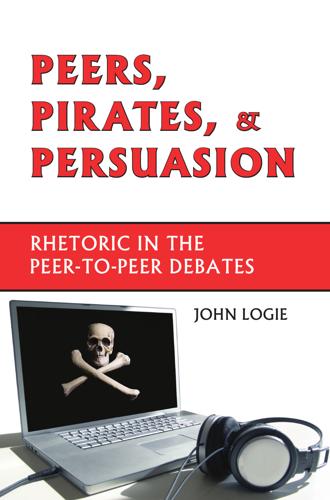
Peers, Pirates, and Persuasion: Rhetoric in the Peer-To-Peer Debates
by
John Logie
Published 29 Dec 2006
That said, peer-to-peer technologies have been reaching for the heavens for some time, and doing so with a remarkable coordination and efficiency. According to recent estimates, over five million users of the SETI@home peer-to-peer network have donated nineteen billion cycles of processing power to searching the heavens for signs of intelligent extraterrestrial life. To put this in a kind of perspective, a single computer would need to work well over two million years to process the data that the collective network of computers has processed since 1999. And even this is a false comparison, as SETI@Home depends, in significant part, on the presence of an array of networked computers for its functionality.

The Secret War Between Downloading and Uploading: Tales of the Computer as Culture Machine
by
Peter Lunenfeld
Published 31 Mar 2011
Twenty-five years ago, the University of California at Berkeley team would have trained a group of laboratory assistants, and set them to work for the next four or five years. But the Stardust team had another model to draw on. For more than a decade, ordinary people had been not just willing but also eager to turn part of their computer’s run cycles over to the Search for Extraterrestrial Intelligence project. The SETI@ home distributed computing initiative has been wildly successful for almost a decade. It sends out chunks of data (or “work units”) to computers all over the world, and the users then send the results back. Users’ willingness to share their untapped computing power means that the Search for Extraterrestrial Intelligence (SETI) project does not need to purchase extra supercomputers or rent time on them.
…
Robert, 150 Oracle, 172–173 Order of the British Empire, 18 Otivion, 101 Ourobors, 175 Oxford Internet Institute, 83 Packard, Dave, 145, 157 Pac-Man game, 71 Page, Larry, 144, 174–176 Paris, 66 Parker, Charlie “Bird,” 25 Participation affordances and, 16–17 bespoke futures and, 98–99, 120–121, 129 culture machine and, 143–147, 151, 156–165, 170, 175–178 fan-based production and, 28–32 Licklider and, 151–152 MP3s and, 27 simulation and, 15–17 stickiness and, 15–17, 27–35 toggling and, 33–34, 43, 102, 197n30 tweaking and, xvi, 32–35, 185nn22,23 unimodernism and, 54, 66–67, 74–80 Web n.0 and, 79–95 Patio potatoes, 9–10, 13 Patriarchs Bush and, 52, 108, 144, 147–152, 157 description of term, xv development of computer and, 143–144, 147–158, 162–163, 166–168 Licklider and, 108, 144, 147–148, 151–152, 158, 163, 168 Paul, Frank R., 109, 109–110 PBS, 68 PDP minicomputer, 71 Peer-to-peer networks, 15, 54, 92, 116, 126 Perot, Ross, 145 Perpetual beta, 36 Personal digital assistants (PDAs), 17 Petrini, Carlo, 5–6 Photography, 15, 40–42, 46–47, 64, 109, 150, 176 Photoshop, 131 Picasso, Pablo, 93 210 INDEX Pico Swap Mart, 105 Pirate Bay, 92 Pixar, 167 Pizza Hut, 5 Plagiarism, 41 Play, 188n25 bespoke futures and, 110–111, 130–131 culture machine and, 143, 153, 160–163 gaming and, 15, 23, 33–34, 57, 67, 70–74, 72, 188n25 meaningfulness and, 32–34 modders and, 69–70 power and, 32–34 rejuveniles and, 67 running room and, 74–77 stickiness and, 13, 15, 32–34, 70–74 toggling and, 33–34, 43, 102, 197n30 tweaking and, xvi, 32–35, 185n22, 185n23 unimodernism and, 39, 53, 55, 62, 64, 67–77 video games and, 15, 23, 33–34, 57, 67, 72, 188n25 Web n.0 and, 85, 88 Play space, 74–77 Plug-in Drug, The (Winn), xii Plutocrats culture machine and, 144, 152–159, 163–166, 170 description of term, xv Hewlett and, 145, 157 Moore and, 156 Noyce and, 156 Packard and, 145, 157 profit and, xv Watsons and, 144, 153–157, 165–166 Plutopian meliorism, xvi, 127–129, 133, 137–138 Poetry, 14, 18–19, 136, 145 Politics African National Congress and, 113 211 Berlin Wall and, xvi, 85, 97, 99, 104 Communism and, 97–98, 103 copyright and, 88–93 Cuban Missile Crisis and, xi fantasies of, 104 New Economy and, 104 propaganda and, 31, 103, 124 scenario planning and, 111–119, 191n19, 192n20 Slow Food and, 5–7 Soviet Union and, xi, 31, 49–52, 59, 73, 85, 88, 97, 102–107, 146 Tiananmen Square and, 104 Velvet Revolution and, 104 Pong, 71 Popper, Karl, 107 Popular Mechanics magazine, 69 Pop-up ads, 23 Positivism, 10, 125 Postmodernism, 29–30, 39–41, 74, 79, 130, 135 PostScript World, 55–56, 102 Poststructuralism, 29–30 Power, 8 bespoke futures and, 98–103, 112– 116, 119–126, 129–130, 136–137 culture machine and, 143, 147, 150– 151, 155–156, 163, 166, 169, 175 meaningfulness and, 32–34 play and, 32–34 stickiness and, 13, 17, 22, 30–34 toggling and, 33–34, 43, 102, 197n30 tweaking and, xvi, 32–35, 185nn22,23 unimodernism and, 39, 49–50, 62, 71–75 Web n.0 and, 81–87, 90–95 PowerBook, 39 Pro bono work, 111 Production appropriation and, 28, 31, 35, 41 balance and, 13 collaborative, 30 INDEX Production (continued) continuous partial, 34 DIY movements and, 67–70 fan culture and, 28–32, 48 mashing and, 25, 54–55, 57, 74 mechanization and, 44–45 modders and, 69–70 open source, 36, 61, 69, 74–75, 91–92, 116, 121–126, 144, 170– 173, 177, 189n12 plagiarism and, 41 remixing and, 27, 35, 39, 53–54, 62–63, 70, 92–94, 129, 189n12 toggling and, 33–34, 43, 102, 197n30 tweaking and, xvi, 32–35, 185nn22,23 unfinish and, xvi, 34–37, 51, 67, 70, 76–79, 92, 127–129, 136 WYMIWYM (What You Model Is What You Manufacture) and, 64–67, 74, 131 Propaganda, 31, 103, 124 Prosumers, 120–121 Psychology culture machine and, 151, 161 Gestalt, 42–43 Licklider and, 151 propaganda and, 31, 103, 124 scenario planning and, 111–119, 191n19, 192n20 stickiness and, 16, 21–22 unimodernism and, 42–44, 56 Public domain, 91 Publishing, 31, 190n8 bespoke future and, 109–110, 112 culture machine and, 146, 148–149, 168 DIY movement and, 67–69 Gutenberg press and, 11, 137–138 unimodernism and, 55–65, 68 Puccini, Giacomo, 61 Punk aesthetic, 46, 67–68, 87, 110 Quantum theory, 148 Radio, 8 Radio frequency identification devices (RFIDs), 65 Radiohead, 39 Ramayana, 28 Rand, Paul, 43 Raymond, Eric, 172 Raytheon, 149 Rear Window (film), 44 Relativity, 49–50, 186n4 Religion, xi, 1, 13, 76, 130–135, 138 Remixing, 27, 94, 129, 189n12 appropriation and, 28, 31, 35, 41 Creative Commons and, 92 Moulin Rouge and, 60–63 unimodernism and, 39, 53–54, 53–55, 62–63, 70 Renaissance, 60 Rent (Larson), 61 Reperceiving, 112–113 Reuters Spectracolor Board, 9 Revivalism, 60 Reyner Banham Loves Los Angeles (BBC documentary), 10 Rheingold, Howard, 145 Rick’s Café, 90 Roberts, Alwyn “Lord Kitchener,” 25–27 Robot butlers, xiv Rockefeller, John D., 166 Rolling Stone magazine, 67 Romanticism, 103 Romeo and Juliet (hip-hop version), 61 Roosevelt, Franklin D., 148 Rope (film), 44 Roux, A., 11 Royal Dutch Shell, 112, 112–113 Royal Library of Alexandria, 89 R-PR (Really Public Relations), xvi, 123–127 RSS feeds, xvii Rumsfeld, Donald, 99 Running room, 74–77 Run time, 57 212 INDEX environmental perception and, 16 memes and, 19, 53–54, 76, 87, 91, 98, 113, 143–144, 149–150, 156–162, 165–170, 178, 194n1 mimicry and, xvii MP3s and, 27 participation and, 15–17 stickiness and, 15–19, 27, 32, 35 unimodernism and, 39, 49, 53–54, 57, 71–76 Sinatra, Frank, 63 Skype, 15 Skyscrapers, xiv Slow movements, 5–7, 181n7 Slurpees, 4 “Smells Like Teen Spirit” (Nirvana), 62 Smith & Hawken, 113 Snakes on a Plane (film), 30 Snow White (Disney film), 20 Social issues advertisement and, 23, 52, 57, 59, 107, 175–177, 184nn12,15 Aquarians and, xv, 144, 152, 157, 159–169 atomic age and, xi (see also Atomic age) Berlin Wall and, 85, 97, 99, 104 bespoke futures and, xvi, 97–139 blogosphere and, xvii, 30, 34, 49, 68, 80, 92–93, 101, 175, 177, 181n7 capitalism and, 4, 13, 66, 75, 90, 97–100, 103–105 capitulationism and, 7, 24, 182n1 cell phones and, xiii, 23, 42, 53, 56, 76, 101 Communism and, 97–98, 103 computers and, xvi, 5, 15–19 (see also Computers) Cuban Missile Crisis and, xi dangers of overabundance and, 7–10 desk jobs and, 3 89/11 and, xvi, 97, 100–102, 105, 130 Enlightenment and, xvi, 129–139 Sacred texts, 28 Saint Laurent, Yves, 60 Saks Fifth Avenue, 31 Samizdat, 59 Scenario planning bespoke futures and, 111–119, 191n19, 192n20 chaos theory and, 117–119 crafting of, 113–116 Ogilvy and, 113–114 Schwartz and, 113–114 Scènes de la vie Bohème (Murger), 61 Schindler, Rudolph, 45 Schrödinger, Erwin, 49 Schwartz, Peter, 113–115, 119 Scott, Ridley, 107 Scratching, 53 Searchers, 167, 177–178 Brin and, 144, 174–176 description of term, xv–xvi Page and, 144, 174–176 Sears, 103–105 September 11, 2001, xvi–xvii, 99–101, 130 SETI@home, 122 Sex, 7, 19, 88, 129–130, 167 Shakespeare, William, 28, 44 Shannon, Claude, 148 Shockley, William, 156 Shockley Semiconductor Laboratory, 156 Silicon Valley, 149, 161, 164 Silly Symphonies (Disney film), 88 Simon, John, Jr., 39 Simulation, xvi, 2, 11 affordances and, 16–17 bespoke futures and, 98, 121, 124, 126–127 buttons/knobs and, 16 communication devices and, 15–16 culture machine and, 143–144, 147– 152, 156–160, 166–168, 175–178 downloading and, 143, 168 emulation and, 183n3 213 INDEX Social issues (continued) figure/ground and, xvi, 42–43, 46, 102 folksonomies and, 80–81 hackers and, 22–23, 54, 67, 69, 162, 170–173 Holocaust and, 107 Hosts and, xv, 144, 167, 175 hypercontexts and, xvi, 7, 48, 76–77 information overload and, 22, 149 MaSAI and, xvi, 112, 120–123, 127, 193nn32 meaningfulness and, xvi, 14, 17, 20, 23–29, 42, 67, 77, 79, 119, 123, 128–129, 133, 173 narrative and, xv, 2, 7–8, 58–59, 67, 71, 76, 108, 110, 130–132, 143– 145, 174, 178, 180n4, 188n25, 193n34 personal grounding and, xiv–xv play and, xvi, 13, 15, 32–34, 39, 53, 55, 62, 64, 67–77, 85, 88, 110–111, 130–131, 143, 153, 160–163, 185n22, 188n25 Plutocrats and, xv, 144, 152–159, 163–166, 170 plutopian meliorism and, xvi, 127–129, 133, 137–138 power and, xvi, 8, 13, 17, 22 (see also Power) relationship with data and, 32 religion and, xi, 1, 13, 76, 130–135, 138 R-PR (Really Public Relations) and, xvi, 123–127 Searchers and, xv–xvi, 144, 167, 174–178 suburbs and, 3, 8 television and, xii (see also Television) terrorism and, 99–101, 130–131, 134, 137 unfinish and, xvi, 34–37, 51, 67, 70, 76–79, 92, 127–129, 136 urban planning and, 84–86 utopia and, 36, 73, 97, 101, 104, 108, 110, 120, 127–129, 138 wants vs. needs and, 13, 37, 57 wicked problems and, 158 World War I era and, 21, 107, 123, 146, 190n1 World War II era and, xi, 18, 25, 32, 47, 73, 107–108, 144–150, 157, 170 Socialists, 102–105 Software platforms, 15, 164, 170 Sontag, Susan, 135 Sopranos, The (TV show), 7 Soundscapes, 53–55 Soviet Union, 31, 85, 88, 146 Berlin Wall and, 85, 97, 99, 104 Cuban Missile Crisis and, xi Exhibition of the Achievement of the Soviet People’s Economy (VDNX) and, 102–105 fall of, 104 gulags of, 107 samizdat and, 59 unimodernism and, 49–52, 73 Space Invaders, 71 Spacewar!
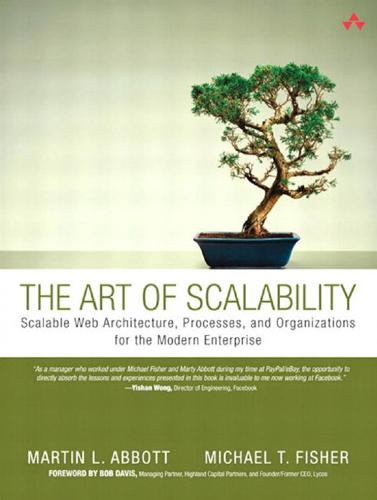
The Art of Scalability: Scalable Web Architecture, Processes, and Organizations for the Modern Enterprise
by
Martin L. Abbott
and
Michael T. Fisher
Published 1 Dec 2009
Private networks include dedicated farms of small commodity servers used with grid middleware to allow for parallel computing. Other private networks include corporate offices where personal computers are used after hours for parallel computing. One of the most well known public network examples of grid computing is the SETI@home project. This project uses computers connected to the Internet in the Search for Extraterrestrial Intelligence (SETI). Individuals can participate by running a program on their personal computers that downloads and analyzes radio telescope data. It then sends the results back to the central system that aggregates completed jobs.
…
Grid computing implementations vary, and some are wholly dedicated to grid computing all day, whereas others are utilized as other types of computers during the day and connected to the grid at night when no one is using them. For grids that are utilizing surplus capacity, this approach is known as CPU scavenging. One of the most well-known grid scavenging programs has been SETI@home that utilizes unused CPU cycles on volunteers’ computers in a search for extraterrestrial intelligence in radio telescope data. There are obviously drawbacks of utilizing spare capacity that include unpredictability of the number of hosts and the speed or capacity of each host. When dealing with large corporate computer networks or standardized systems that are idle during the evening, these drawbacks are minimized.
…
As one service or particular computation has more demand placed on it, instead of scaling the entire application or suite of services along an x-axis (horizontal duplication), 457 458 C HAPTER 30 P LUGGING IN THE G RID you can be much more specific and scale only the service or computation that requires the growth. This allows you to spend much more efficiently only on the capacity that is necessary. The other advantage in terms of cost can come from scavenging spare cycles on desktops or other servers, as described in the previous paragraph referencing the SETI@home program. Pros of Grid Computing We have identified three major benefits of grid computing. These are listed in no particular order and are not all inclusive. There are many more benefits, but these are representative of the types of benefits you could expect from including grid computing in your infrastructure. • High computation rates.
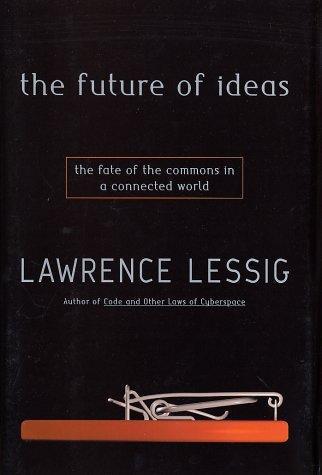
The Future of Ideas: The Fate of the Commons in a Connected World
by
Lawrence Lessig
Published 14 Jul 2001
A package of data would be delivered to the participating computer along with a program to be run; that program would run on the data and send it back to the mother ship. When the SETI@home project first began, within ten days it had 350,000 participants in 203 countries. In four months, it broke a million users. The service grew so fast that it had to stop processing data for a while. The speed at which data was being collected had surpassed the processing speed. In mid-2000, the system could boast the equivalent of 280,000 years of processing time devoted to the SETI mission.29 Just as Napster had latched on to unused disk space, SETI@home had latched on to unused computer cycles living at the edge of the Net.
…
(Beijing and Cambridge, Mass: O'Reilly, 2001), 3-15 (describing how the original Internet was “fundamentally designed as a peer-to-peer system” but became increasingly client/server oriented over time owing to Web browser applications, firewalls, and other factors). 28 For background on SETI, see “History of SETI,” at http://www.seti-inst.edu/ general/history.html; Eric Korpela et al., “SETI@home: Massively Distributed Computing for SETI,” at http://www.computer.org/cise/articles/seti.htm. 29 Howard Rheingold, “You Got the Power,” Wired (August 2001), at http://www.wired. com/wired/archive/8.08/comcomp.html?pg=1&topic=&topic_set=. 30 For a useful survey of issues related to P2P, see Peer-to-Peer: Harnessing the Benefits of a Disruptive Technology, Andrew Oram, ed.

Protocol: how control exists after decentralization
by
Alexander R. Galloway
Published 1 Apr 2004
“[C]onsider a biological disease that is 100% infectious, spreads whenever animals communicate, kills all infected animals instantly at a given moment, and has no detectable side effect until that moment,”8 wrote Cohen, identifying the ultimate inaccuracy of the analogy. How did self-replicating programs become viruses? For example, if viruses had emerged a decade later, in the late 1990s, it is likely that they would have a completely difference sociocultural meaning. They would most certainly be thought of more as a distributed computing system (like SETI@home) or an artificial life experiment (like Tom Ray’s Tierra), or an artwork (like Mark Daggett’s email worm, vcards), or as a nuisance (spam), or as a potential guerilla marketing tool (adware)—not a biological infestation. Computer viruses acquired their current discursive position because of a unique transformation that transpired in the mid-1980s around the perception of technology.
…
See also Domain Name System (DNS) Resolution, low, 67 Reverse engineer, 172 RFC editor, 121–122, 132, 134–135 Rhizome, 19, 47, 49, 215, 238 Rhizome (diagram), 24, 33–34, 46, 61, 197, 206 Ritchie, Dennis, 108n89, 123 Robot, 107n88 Robustness, 42–44, 46, 243 Ronfeldt, David, 30n2, 196, 204 Root server, 9–10, 49. See also Domain Name System (DNS) Ross, Andrew, 170 Ross, David, 209 Routing, 44–45 RTMark, 219, 228, 235 Ruling the Root (Mueller), 18 R.U.R. (Čapek), 102 Rushkoff, Douglas, 229 September 11 (2001), 201 Server, 39, 217 SETI@home, 178 Shelley, Mary, 102 Shulgin, Alexei, 211, 215–216, 219, 225 Sisco, Elizabeth, 227n32 Situationism, 194 Slatalla, Michelle, 161 Smith, David, 184 Social sculpture, 81 Social Security Act, 13 Society control, 3, 81, 86 disciplinary, 21, 23, 25, 86 sovereign, 21, 23 (see also Sovereignty) “Society Must Be Defended” (Foucault), 82 Software, 219 and art, 226–238 “Software” (exhibition), 210n7 Sony.

WTF?: What's the Future and Why It's Up to Us
by
Tim O'Reilly
Published 9 Oct 2017
This was a kind of decentralization beyond even the World Wide Web. It was becoming clear that the future demanded even more extreme rethinking of what the Internet could become as a platform for next-generation software applications and content. Nor was this future limited to file sharing. The SETI@home project, started in mid-1999, was signing up Internet users to contribute unused computing power on their home PCs to analyze radio telescope signals for signs of extraterrestrial intelligence. Computation, not just files and data, could be split across thousands of computers. And developers were increasingly beginning to understand that the powerful applications of the web could be treated as components callable by other programs—what we now call “web services.”
…
See also data Information, The (tech report), 287 innovation waves, xxiii, 46–47, 339 Innovator’s Dilemma, The (Christensen), 351 Instagram, 96–97, 102 Intel, 12–13, 33 Internet and business organization changes, 123–24 commercializing process, 79–81 communications role, 90 cybercrime, 208–9 economic value of, 97 file sharing between users, 25–26 freedom leads to growth, 100–101 free software people and, 15 and GNN, 28–29, 38–39, 79–81, 89, 276 as neutral platform, 202–3 open source infrastructure, 19, 20 as operating system, 27–28, 35, 41 packet switching, 106–7 peer-to-peer file sharing, 26–27 programmers work from inside the application, 120–24 proprietary applications running on open source software, 25 SETI@home project, 26 survey of users, 81 TCP/IP development, 107–8 web spidering, 110 See also World Wide Web Internet Creators Guild, 289 Internet in a Box, 81 invention obvious in retrospect, 71–75 invisible hand theory, 262–70 iPhone, xiii, 32, 128, 136 iPhone App Store, 101, 128, 136 issue-tracking systems, 118–19 “It’s Still Day 1” (Bezos), 124 iTunes, 31 Jacobsen, Mark, 285 Janeway, Bill, 104–5, 115, 238, 247, 263, 274, 277–78, 284 Jefferson, Thomas, 130 Jensen, Michael, 240–41 jobs, xxvi, 301–3, 308, 320–21 and AI, xx–xxi, 91–92, 232–33 caring and sharing aspects, 308–11, 323–24, 332–33 creativity-based, 312–19 displacement and transformation of, 94 and education/training, 303, 304 independent contractor status at Uber and Lyft, 59 labor globalization, 67 and new technology, xvii optimism about the future, 298–302 reducing work hours, 304, 308–11 replacing with higher-value tasks, 94–95 universal basic income for, 305–6, 307–11 See also augmented workers; employees Jobs, Steve, 70, 313 Johnson, Bryan, 330 Johnson, Clay, 149 Johnson, Samuel, 313 Johri, Akhil, 256 Just for Fun (Torvalds), 14 Kahn, Bob, 107 Kalanick, Travis, 54, 69, 75 Kaplan, Esther, 193 Kasriel, Stephane, 333–34 Katsuyama, Brad, 237–38 Kernighan, Brian, 105–6 Kettl, Donald, 129 Keynes, John Maynard, 271–72, 298 Kickstarter, 291–92 Kilpi, Esko, 89–90 Kim, Gene, 122–23 Klein, Ezra, 143 knowledge, sharing vs. hoarding, 296–97, 323–25 Korea, 134 Korzybski, Alfred, 20, 195, 211, 314 Kressel, Henry, 284 Krol, Ed, 28 Kromhout, Peter, 116–17 Kwak, James, 258 labor globalization, 67 labor movement, 262–63 Lang, David, 183 language, 20–21, 323–24 language translation, 155–56, 165–66 Lanier, Jaron, 96 laser eye surgery, xvii Launchbury, John, 209 LaVecchia, Olivia, 103 Law of Conservation of Attractive Profits (Christensen), 24–25, 33–34, 331 Lazonick, William, 245, 247 Learning by Doing (Bessen), 345–47 LeCun, Yann, 164–65, 167, 234, 297 leisure time, 309–10, 314 Lessig, Larry, 130–31 Lessin, Jessica, 287 Lessin, Sam, 331 Levi, Margaret, 60 Levie, Aaron, 85–86 Lewis, Michael, 237 Lincoln, Abraham, 150, 323 Linux Kongress, Würzburg, Germany, 8–11 Linux operating system, xii, 7, 8, 23, 24 Long Now Foundation, 355–56 Loosemore, Tom, 186–87 “Looting” (Akerlof and Romer), 249 Lopez, Nadia, 371 Loukides, Mike, 38 Lucovsky, Mark, 119 Lyft, 47, 54–55, 58, 70, 77, 94, 183, 262, 318.
…
See also Google Seattle, Washington, 138–40 Second Machine Age (McAfee), xxii–xxiii secular stagnation, 271 Securities and Exchange Commission (SEC), 125–26 security on platforms, 135–36 self-driving vehicles, 232–33 data collection for, 32–33, 34–35 jobs resulting from, 94–95 as manifestation of the global brain, 46 National Highway Traffic Safety Administration regulations, 188–89 for Uber and Lyft, x, 62–64 self-service marketplaces, 91 sensors, xviii–xix, 33, 34–35, 40, 41, 85, 176–77, 326 SETI@home project, 26 sewing as WTF? technology, 322–23 Shakespeare, 171 shareholder capitalism, 240–41, 245–51, 256, 263–68, 292 Shareholder Value Myth, The (Stout), 292 Shirky, Clay, 27, 91 Sidecar, 54–55, 77 Silicon Valley. See economy and Silicon Valley Simon, George, 20 Site Reliability Engineering (SRE), 123, 146–47 Skynet moment, 241.

Utopia Is Creepy: And Other Provocations
by
Nicholas Carr
Published 5 Sep 2016
“We will definitely see dynamically-priced queues for confession-taking priests, and therapists!” exclaims Levchin. And from there we can move on to maximizing the utilization of the human mind itself. “How about dynamic pricing for brain cycles?” he asks, his excitement mounting. “Just like the SETI@Home screensaver ‘steals’ CPU cycles to sift through cosmic radio noise for alien voices, your brain plug firmware will earn you a little extra cash while you sleep, by being remotely programmed to solve hard problems, like factoring products of large primes.” Yes, he’s serious. “As soon as the general public is ready for it, many things handled by a human at the edge of consumption will be controlled by the best currently available human at the center of the system, real-time sensors bringing the necessary data to them in real time.”
…
(Coupland), 102 Martin, Paul, 335 Marx, Karl, Marxism, xvii, xviii, 26, 83, 174, 308 Marx, Leo, 131 Maslow, Abraham, 117–20 massive open online courses (MOOCs), 133 master-slave metaphor, 307–9 mastery, 64–65 Mayer, Marissa, 268 Mayer-Schönberger, Viktor, 48 McAfee, Andrew, 195 McCain, John, 318 McKeen, William, 13–15 McLuhan, Marshall, 102–6, 183–84, 232, 326 McNealy, Scott, 257 measurement, 182 of experience, 197–98, 211–12 mechanical loom, 77 Mechanical Turk, 37–38 media: as advertorial, 53 big outlets for, 67 changes in, 53–54, 59–60 democratization of, xvi, xviii, 28 hegemony of internet in, 236–37 intellectual and social effects of, 103–6 as invasive, 105–6, 127–30 mainstream, 7–8 pursuit of immediacy in, 79 real world vs., 223 in shaping thought, 232 smartphones’ dominance of, 183–84 tools vs., 226 meditation, 162 Mehta, Mayank, 303 memory: association and cohesion in, 100–101 computer, 147, 231 cultural, 325–28 digital, 327 effect of computers on, 98–101, 234, 240 internet manipulation of, 48 neuroengineering of, 332–34 packaging of, 186 in revivification, 69–70 spatial, 290 time vs., 226 video games and, 94–97 Merholz, Peter, 21 Merleau-Ponty, Maurice, 300 Merton, Robert, 12–13 message-automation service, 167 Meyer, Stephenie, 50 Meyerowitz, Joanne, 338 microfilm, microphotography, 267 Microsoft, 108, 168, 205, 284 military technology, 331–32 Miller, Perry, xvii mindfulness, 162 Minima Moralia (Adorno), 153–54 mirrors, 138–39 Mitchell, Joni, 128 Mollie (video poker player), 218–19 monitoring: corporate control through, 163–65 of thoughts, 214–15 through wearable behavior-modification devices, 168–69 Montaigne, Michel de, 247, 249, 252, 254 Moore, Geoffrey, 209 Morlocks, 114, 186 “Morphological Basis of the Arm-to-Wing Transition, The” (Poore), 329–30 Morrison, Ewan, 288 Morrison, Jim, 126 Morse code, 34 “Most of It, The” (Frost), 145–46 motor skills, video games and, 93–94 “Mowing” (Frost), 296–300, 302, 304–5 MP3 players, 122, 123, 124, 216, 218, 293 multitasking, media, 96–97 Mumford, Lewis, 138–39, 235 Murdoch, Rupert and Wendi, 131 music: bundling of, 41–46 commercial use of, 244–45 copying and sharing technologies for, 121–26, 314 digital revolution in, 293–95 fidelity of, 124 listening vs. interface in, 216–18, 293 in participatory games, 71–72 streamed and curated, 207, 217–18 music piracy, 121–26 Musings on Human Metamorphoses (Leary), 171 Musk, Elon, 172 Musset, Alfred de, xxiii Muzak, 208, 244 MySpace, xvi, 10–11, 30–31 “Names of the Hare, The,” 201 nanotechnology, 69 Napster, 122, 123 narcissism, 138–39 Twitter and, 34–36 narrative emotions, 250 natural-language processing, 215 Negroponte, Nicholas, xx neobehavioralism, 212–13 Netflix, 92 neural networks, 136–37 neuroengineering, 332–33 New Critics, 249 News Feed, 320 news media, 318–20 newspapers: evolution of, 79, 237 online archives of, 47–48, 190–92 online vs. printed, 289 Newton, Isaac, 66 New York Public Library, 269 New York Times, 8, 71, 83, 133, 152–53, 195, 237, 283, 314, 342 erroneous information revived by, 47–48 on Twitter, 35 Nielsen Company, 80–81 Nietzsche, Friedrich, 126, 234–35, 237 Nightingale, Paul, 335 Nixon, Richard, 317 noise pollution, 243–46 Nook, 257 North of Boston (Frost), 297 nostalgia, 202, 204, 312 in music, 292–95 Now You See It (Davidson), 94 Oates, Warren, 203 Oatley, Keith, 248–50 Obama, Barack, 314 obsession, 218–19 OCLC, 276 “off grid,” 52 Olds, James, 235 O’Neill, Gerard, 171 One Infinite Loop, 76 Ong, Walter, 129 online aggregation, 192 On Photography (Sontag), xx open networks, profiteering from, 83–85 open-source projects, 5–7, 26 Oracle, 17 orchises, 305 O’Reilly, Tim, 3–5, 7 organ donation and transplantation, 115 ornithopters, 239 orphan books, 276, 277 Overture, 279–80 Owad, Tom, 256 Oxford Junior Dictionary, 201–2 Oxford University, library of, 269 Page, Larry, 23, 160, 172, 239, 268–69, 270, 279, 281–85 personal style of, 16–17, 281–82, 285 paint-by-number kits, 71–72 Paley, William, 43 Palfrey, John, 272–74, 277 Palmisano, Sam, 26 “pancake people,” 242 paper, invention and uses of, 286–89 Paper: An Elegy (Sansom), 287 Papert, Seymour, 134 Paradise within the Reach of All Men, The (Etzler), xvi–xvii paradox of time, 203–4 parenting: automation of, 181 of virtual child, 73–75 Parker, Sarah Jessica, 131 participation: “cognitive surplus” in, 59 as content and performance, 184 inclusionists vs. deletionists in, 18–20 internet, 28–29 isolation and, 35–36, 184 limits and flaws of, 5–7, 62 Paul, Rand, 314 Pendragon, Caliandras (avatar), 25 Pentland, Alex, 212–13 perception, spiritual awakening of, 300–301 personalization, 11 of ads, 168, 225, 264 isolation and, 29 loss of autonomy in, 264–66 manipulation through, 258–59 in message automation, 167 in searches, 145–46, 264–66 of streamed music, 207–9, 245 tailoring in, 92, 224 as threat to privacy, 255 Phenomenology of Perception (Merleau-Ponty), 300 Philosophical Investigations (Wittgenstein), 215 phonograph, phonograph records, 41–46, 133, 287 photography, technological advancement in, 311–12 Pichai, Sundar, 181 Pilgrims, 172 Pinterest, 119, 186 playlists, 314 PlayStation, 260 “poetic faith,” 251 poetry, 296–313 polarization, 7 politics, transformed by technology, 314–20 Politics (Aristotle), 307–8 Poore, Samuel O., 329–30 pop culture, fact-mongering in, 58–62 pop music, 44–45, 63–64, 224 copying technologies for, 121–26 dead idols of, 126 industrialization of, 208–9 as retrospective and revivalist, 292–95 positivism, 211 Potter, Dean, 341–42 power looms, 178 Presley, Elvis, 11, 126 Prim Revolution, 26 Principles of Psychology (James), 203 Principles of Scientific Management, The (Taylor), 238 printing press: consequences of, 102–3, 234, 240–41, 271 development of, 53, 286–87 privacy: devaluation of, 258 from electronic surveillance, 52 family cohesion vs., 229 free flow of information vs. right to, 190–94 internet threat to, 184, 255–59, 265, 285 safeguarding of, 258–59, 283 vanity vs., 107 proactive cognitive control, 96 Prochnik, George, 243–46 “Productivity Future Vision (2011),” 108–9 Project Gutenberg, 278 prosperity, technologies of, 118, 119–20 prosumerism, 64 protest movements, 61 Proust and the Squid (Wolf), 234 proximal clues, 303 public-domain books, 277–78 “public library,” debate over use of term, 272–74 punch-card tabulator, 188 punk music, 63–64 Quantified Self Global Conference, 163 Quantified Self (QS) movement, 163–65 Quarter-of-a-Second Rule, 205 racecars, 195, 196 radio: in education, 134 evolution of, 77, 79, 159, 288 as music medium, 45, 121–22, 207 political use of, 315–16, 317, 319 Radosh, Daniel, 71 Rapp, Jen, 341–42 reactive cognitive control, 96 Readers’ Guide to Periodical Literature, 91 reading: brain function in, 247–54, 289–90 and invention of paper, 286–87 monitoring of, 257 video gaming vs., 261–62 see also books reading skills, changes in, 232–34, 240–41 Read Write Web (blog), 30 Reagan, Ronald, 315 real world: digital media intrusion in, 127–30 perceived as boring and ugly, 157–58 as source of knowledge, 313 virtual world vs., xx–xxi, 36, 62, 127–30, 303–4 reconstructive surgery, 239 record albums: copying of, 121–22 jackets for, 122, 224 technology of, 41–46 Redding, Otis, 126 Red Light Center, 39 Reichelt, Franz, 341 Reid, Rob, 122–25 relativists, 20 religion: internet perceived as, 3–4, 238 for McLuhan, 105 technology viewed as, xvi–xvii Republic of Letters, 271 reputations, tarnishing of, 47–48, 190–94 Resident Evil, 260–61 resource sharing, 148–49 resurrection, 69–70, 126 retinal implants, 332 Retromania (Reynolds), 217, 292–95 Reuters, Adam, 26 Reuters’ SL bureau, 26 revivification machine, 69–70 Reynolds, Simon, 217–18, 292–95 Rice, Isaac, 244 Rice, Julia Barnett, 243–44 Richards, Keith, 42 “right to be forgotten” lawsuit, 190–94 Ritalin, 304 robots: control of, 303 creepy quality of, 108 human beings compared to, 242 human beings replaced by, 112, 174, 176, 195, 197, 306–7, 310 limitations of, 323 predictions about, xvii, 177, 331 replaced by humans, 323 threat from, 226, 309 Rogers, Roo, 83–84 Rolling Stones, 42–43 Roosevelt, Franklin, 315 Rosen, Nick, 52 Rubio, Marco, 314 Rumsey, Abby Smith, 325–27 Ryan, Amy, 273 Sandel, Michael J., 340 Sanders, Bernie, 314, 316 Sansom, Ian, 287 Savage, Jon, 63 scatology, 147 Schachter, Joshua, 195 Schivelbusch, Wolfgang, 229 Schmidt, Eric, 13, 16, 238, 239, 257, 284 Schneier, Bruce, 258–59 Schüll, Natasha Dow, 218 science fiction, 106, 115, 116, 150, 309, 335 scientific management, 164–65, 237–38 Scrapbook in American Life, The, 185 scrapbooks, social media compared to, 185–86 “Scrapbooks as Cultural Texts” (Katriel and Farrell), 186 scythes, 302, 304–6 search-engine-optimization (SEO), 47–48 search engines: allusions sought through, 86 blogging, 66–67 in centralization of internet, 66–69 changing use of, 284 customizing by, 264–66 erroneous or outdated stories revived by, 47–48, 190–94 in filtering, 91 placement of results by, 47–48, 68 searching vs., 144–46 targeting information through, 13–14 writing tailored to, 89 see also Google searching, ontological connotations of, 144–46 Seasteading Institute, 172 Second Life, 25–27 second nature, 179 self, technologies of the, 118, 119–20 self-actualization, 120, 340 monitoring and quantification of, 163–65 selfies, 224 self-knowledge, 297–99 self-reconstruction, 339 self-tracking, 163–65 Selinger, Evan, 153 serendipity, internet as engine of, 12–15 SETI@Home, 149 sexbots, 55 Sex Pistols, 63 sex-reassignment procedures, 337–38 sexuality, 10–11 virtual, 39 Shakur, Tupac, 126 sharecropping, as metaphor for social media, 30–31 Shelley, Percy Bysshe, 88 Shirky, Clay, 59–61, 90, 241 Shop Class as Soulcraft (Crawford), 265 Shuster, Brian, 39 sickles, 302 silence, 246 Silicon Valley: American culture transformed by, xv–xxii, 148, 155–59, 171–73, 181, 241, 257, 309 commercial interests of, 162, 172, 214–15 informality eschewed by, 197–98, 215 wealthy lifestyle of, 16–17, 195 Simonite, Tom, 136–37 simulation, see virtual world Singer, Peter, 267 Singularity, Singularitarians, 69, 147 sitcoms, 59 situational overload, 90–92 skimming, 233 “Slaves to the Smartphone,” 308–9 Slee, Tom, 61, 84 SLExchange, 26 slot machines, 218–19 smart bra, 168–69 smartphones, xix, 82, 136, 145, 150, 158, 168, 170, 183–84, 219, 274, 283, 287, 308–9, 315 Smith, Adam, 175, 177 Smith, William, 204 Snapchat, 166, 205, 225, 316 social activism, 61–62 social media, 224 biases reinforced by, 319–20 as deceptively reflective, 138–39 documenting one’s children on, 74–75 economic value of content on, 20–21, 53–54, 132 emotionalism of, 316–17 evolution of, xvi language altered by, 215 loom as metaphor for, 178 maintaining one’s microcelebrity on, 166–67 paradox of, 35–36, 159 personal information collected and monitored through, 257 politics transformed by, 314–20 scrapbooks compared to, 185–86 self-validation through, 36, 73 traditional media slow to adapt to, 316–19 as ubiquitous, 205 see also specific sites social organization, technologies of, 118, 119 Social Physics (Pentland), 213 Society for the Suppression of Unnecessary Noise, 243–44 sociology, technology and, 210–13 Socrates, 240 software: autonomous, 187–89 smart, 112–13 solitude, media intrusion on, 127–30, 253 Songza, 207 Sontag, Susan, xx SoundCloud, 217 sound-management devices, 245 soundscapes, 244–45 space travel, 115, 172 spam, 92 Sparrow, Betsy, 98 Special Operations Command, U.S., 332 speech recognition, 137 spermatic, as term applied to reading, 247, 248, 250, 254 Spinoza, Baruch, 300–301 Spotify, 293, 314 “Sprite Sips” (app), 54 Squarciafico, Hieronimo, 240–41 Srinivasan, Balaji, 172 Stanford Encyclopedia of Philosophy, 68 Starr, Karla, 217–18 Star Trek, 26, 32, 313 Stengel, Rick, 28 Stephenson, Neal, 116 Sterling, Bruce, 113 Stevens, Wallace, 158 Street View, 137, 283 Stroop test, 98–99 Strummer, Joe, 63–64 Studies in Classic American Literature (Lawrence), xxiii Such Stuff as Dreams (Oatley), 248–49 suicide rate, 304 Sullenberger, Sully, 322 Sullivan, Andrew, xvi Sun Microsystems, 257 “surf cams,” 56–57 surfing, internet, 14–15 surveillance, 52, 163–65, 188–89 surveillance-personalization loop, 157 survival, technologies of, 118, 119 Swing, Edward, 95 Talking Heads, 136 talk radio, 319 Tan, Chade-Meng, 162 Tapscott, Don, 84 tattoos, 336–37, 340 Taylor, Frederick Winslow, 164, 237–38 Taylorism, 164, 238 Tebbel, John, 275 Technics and Civilization (Mumford), 138, 235 technology: agricultural, 305–6 American culture transformed by, xv–xxii, 148, 155–59, 174–77, 214–15, 229–30, 296–313, 329–42 apparatus vs. artifact in, 216–19 brain function affected by, 231–42 duality of, 240–41 election campaigns transformed by, 314–20 ethical hazards of, 304–11 evanescence and obsolescence of, 327 human aspiration and, 329–42 human beings eclipsed by, 108–9 language of, 201–2, 214–15 limits of, 341–42 master-slave metaphor for, 307–9 military, 331–32 need for critical thinking about, 311–13 opt-in society run by, 172–73 progress in, 77–78, 188–89, 229–30 risks of, 341–42 sociology and, 210–13 time perception affected by, 203–6 as tool of knowledge and perception, 299–304 as transcendent, 179–80 Technorati, 66 telegrams, 79 telegraph, Twitter compared to, 34 telephones, 103–4, 159, 288 television: age of, 60–62, 79, 93, 233 and attention disorders, 95 in education, 134 Facebook ads on, 155–56 introduction of, 103–4, 159, 288 news coverage on, 318 paying for, 224 political use of, 315–16, 317 technological adaptation of, 237 viewing habits for, 80–81 Teller, Astro, 195 textbooks, 290 texting, 34, 73, 75, 154, 186, 196, 205, 233 Thackeray, William, 318 “theory of mind,” 251–52 Thiel, Peter, 116–17, 172, 310 “Things That Connect Us, The” (ad campaign), 155–58 30 Days of Night (film), 50 Thompson, Clive, 232 thought-sharing, 214–15 “Three Princes of Serendip, The,” 12 Thurston, Baratunde, 153–54 time: memory vs., 226 perception of, 203–6 Time, covers of, 28 Time Machine, The (Wells), 114 tools: blurred line between users and, 333 ethical choice and, 305 gaining knowledge and perception through, 299–304 hand vs. computer, 306 Home and Away blurred by, 159 human agency removed from, 77 innovation in, 118 media vs., 226 slave metaphor for, 307–8 symbiosis with, 101 Tosh, Peter, 126 Toyota Motor Company, 323 Toyota Prius, 16–17 train disasters, 323–24 transhumanism, 330–40 critics of, 339–40 transparency, downside of, 56–57 transsexuals, 337–38 Travels and Adventures of Serendipity, The (Merton and Barber), 12–13 Trends in Biochemistry (Nightingale and Martin), 335 TripAdvisor, 31 trolls, 315 Trump, Donald, 314–18 “Tuft of Flowers, A” (Frost), 305 tugboats, noise restrictions on, 243–44 Tumblr, 166, 185, 186 Turing, Alan, 236 Turing Test, 55, 137 Twain, Mark, 243 tweets, tweeting, 75, 131, 315, 319 language of, 34–36 theses in form of, 223–26 “tweetstorm,” xvii 20/20, 16 Twilight Saga, The (Meyer), 50 Twitter, 34–36, 64, 91, 119, 166, 186, 197, 205, 223, 224, 257, 284 political use of, 315, 317–20 2001: A Space Odyssey (film), 231, 242 Two-Lane Blacktop (film), 203 “Two Tramps in Mud Time” (Frost), 247–48 typewriters, writing skills and, 234–35, 237 Uber, 148 Ubisoft, 261 Understanding Media (McLuhan), 102–3, 106 underwearables, 168–69 unemployment: job displacement in, 164–65, 174, 310 in traditional media, 8 universal online library, 267–78 legal, commercial, and political obstacles to, 268–71, 274–78 universe, as memory, 326 Urban Dictionary, 145 utopia, predictions of, xvii–xviii, xx, 4, 108–9, 172–73 Uzanne, Octave, 286–87, 290 Vaidhyanathan, Siva, 277 vampires, internet giants compared to, 50–51 Vampires (game), 50 Vanguardia, La, 190–91 Van Kekerix, Marvin, 134 vice, virtual, 39–40 video games, 223, 245, 303 as addictive, 260–61 cognitive effects of, 93–97 crafting of, 261–62 violent, 260–62 videos, viewing of, 80–81 virtual child, tips for raising a, 73–75 virtual world, xviii commercial aspects of, 26–27 conflict enacted in, 25–27 language of, 201–2 “playlaborers” of, 113–14 psychological and physical health affected by, 304 real world vs., xx–xxi, 36, 62, 127–30 as restrictive, 303–4 vice in, 39–40 von Furstenberg, Diane, 131 Wales, Jimmy, 192 Wallerstein, Edward, 43–44 Wall Street, automation of, 187–88 Wall Street Journal, 8, 16, 86, 122, 163, 333 Walpole, Horace, 12 Walters, Barbara, 16 Ward, Adrian, 200 Warhol, Andy, 72 Warren, Earl, 255, 257 “Waste Land, The” (Eliot), 86, 87 Watson (IBM computer), 147 Wealth of Networks, The (Benkler), xviii “We Are the Web” (Kelly), xxi, 4, 8–9 Web 1.0, 3, 5, 9 Web 2.0, xvi, xvii, xxi, 33, 58 amorality of, 3–9, 10 culturally transformative power of, 28–29 Twitter and, 34–35 “web log,” 21 Wegner, Daniel, 98, 200 Weinberger, David, 41–45, 277 Weizenbaum, Joseph, 236 Wells, H.

Is the Internet Changing the Way You Think?: The Net's Impact on Our Minds and Future
by
John Brockman
Published 18 Jan 2011
And we’ve already been able to solve those more tractable equations well enough to guide several revolutions in the material foundations of microelectronics, laser technology, and magnetic imaging. But all these computational adventures, while impressive, are clearly warm-up exercises. To make a definitive leap into artificial reality, we’ll need both more ingenuity and more computational power. Fortunately, both could be at hand. The SETI@home project has enabled people around the world to donate their idle computer time to sift radio waves from space, advancing the search for extraterrestrial intelligence. In connection with the Large Hadron Collider (LHC) project, CERN—where, earlier, the World Wide Web was born—is pioneering the GRID computer project, a sort of Internet on steroids that will allow many thousands of remote computers and their users to share data and allocate tasks dynamically, functioning in essence as one giant brain.
…
Pioneering programs allowing computers to play chess by pure calculation debuted in 1958; they rapidly become more capable, beating masters (1978), grandmasters (1988), and world champions (1997). In the later steps, a transition to massively parallel computers played a crucial role. Those special-purpose creations are mini-Internets (actually mini-GRIDs), networking dozens or a few hundred ordinary computers. It would be an instructive project today to set up a SETI@home-style network or a GRID client that could beat the best stand-alones. Players of this kind, once created, would scale up smoothly to overwhelming strength, simply by tapping into ever larger resources. In the more difficult game of calculating quantum reality, we, with the help of our silicon friends, currently play like weak masters.

Remix: Making Art and Commerce Thrive in the Hybrid Economy
by
Lawrence Lessig
Published 2 Jan 2009
In 2004, there were between three hundred and four hundred proofreaders participating each day; the project finished between four thousand and seven thousand pages per day—averaging four pages every minute.62 All of this work is voluntary. • Distributed-computing projects are sharing economies. Distributed computing refers to efforts to enlist the unused cycles of personal computers connected to the Net for some worthy cause (worthy in the eyes of the volunteer, at least). The most famous was the SETI@home project, launched in 1999 and designed to share computing power for the purpose of detecting extraterrestrial life (or at least the sort that uses radios). More than 5 million volunteers eventually shared their computers with this project.63 But there are many more distributed-computing projects beyond the SETI project.
…
Wikipedia contributors, “Project Gutenberg,” Wikipedia: The Free Encyclopedia, available at link #75 (last visited October 10, 2007). 80706 i-xxiv 001-328 r4nk.indd 310 8/12/08 1:56:25 AM NO T E S 311 61. Ibid., available at link #76 (last visited October 10, 2007). 62. “Beginning Proofreaders’ Frequently Asked Questions,” Distributed Proofreaders, available at link #77 (last visited July 31, 2007). 63. Wikpedia contributors, “SETI@home,” Wikipedia: The Free Encyclopedia, available at link #78 (last visited August 20, 2007). See also Benkler, “Sharing Nicely,” 275. 64. Wikpedia contributors, “Einstein@Home,” Wikipedia: The Free Encyclopedia, available at link #79 (last visited August 20, 2007). 65. “About the Internet Archive,” Internet Archive, available at link #80 (last visited July 31, 2007). 66.
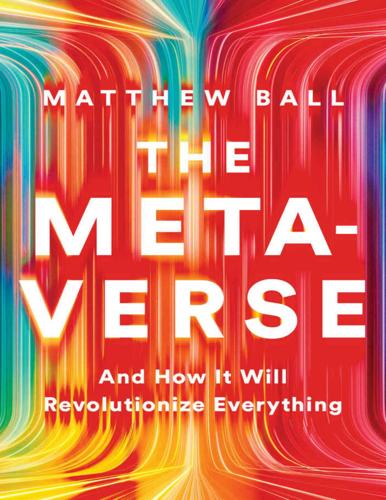
The Metaverse: And How It Will Revolutionize Everything
by
Matthew Ball
Published 18 Jul 2022
Elon Musk touts a future in which your Tesla earns you rent as a self-driving car when you’re not using it yourself—better than just being parked in your garage for 99% of its life. As early as the 1990s programs emerged for distributed computing using everyday consumer hardware. One of the most famous examples is the University of California, Berkeley’s SETI@HOME, wherein consumers would volunteer use of their home computers to power the search for alien life. Sweeney has highlighted that one of the items on his “to-do list” for the first-person shooter Unreal Tournament 1, which shipped in 1998, was “to enable game servers to talk to each other so we can just have an unbounded number of players in a single game session.”
…
on, 11, 31, 43, 111 generational change and, 247, 249 independence of, 275–77 initial public offering (IPO) of, xii interoperability and, 37, 299–300 payments rails in, 191–93 Roblox Premium subscription, 128 virtual goods in, 127–8 Rocket League, 137 Rockstar Games, 112 Roosevelt, Franklin D., ix–x Royal Dutch Shell, 166 Rube Goldberg machines, 56–57, 190, 253 Rumble Pak for the Nintendo 64, 151–52 Russia, 11, 156n, 170 Safari web browser, 194–96, 209 Samsung, 25, 61n, 137, 148, 150, 213, 243 Sandbox, The, 115 Saudi Arabia, 11 Save the Children, 9 Schaldemose, Christel, xiv “Science, the Endless Frontier,” x Scott, Travis, 12, 54–55, 77, 139, 280 Second Life, 9–10, 22, 45, 110, 247, 276 Security Times, xiii, xivn Sega, 173 Sesame Street, 26 SETI@HOME, 101 shared experiences, 48–49, 51 Shopify, 217 Silicon Snake Oil: Second Thoughts on the Information Highway, 308 skeuomorphism, 47, 307 Skybound Entertainment, 260 Skype, 61, 308 Slack, 61, 135, 308 “smart contracts,” 226–30, 300 smart gloves, 151 smart lenses, 154, 205 smartphones, 148–51, 158–62, 188.

As the Future Catches You: How Genomics & Other Forces Are Changing Your Work, Health & Wealth
by
Juan Enriquez
Published 15 Feb 2001
Allen Foundation THE MOORE FOUNDATION The Universities Space Research Association THE PACIFIC SCIENCE CENTER The Foundation for Microbiology SUN MICROSYSTEMS Hewlett-Packard. Those who founded Search for Extraterrestrial Intelligence (SETI) hoped 100,000 global citizens would sign up … More than two million did. And SETI@home is now the world’s largest community computer project … With 280,000 years of processing time available … And a network that grows every week.10 AIDS researchers soon copied this model, linking more than 100,000 PCs in over eighty countries … Creating the world’s largest academic computing site … Designed to understand and attack a virus that mutates very rapidly.11 (And of course, volunteer networks can morph into business networks.
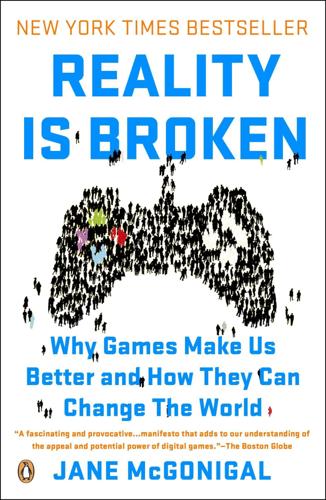
Reality Is Broken: Why Games Make Us Better and How They Can Change the World
by
Jane McGonigal
Published 20 Jan 2011
It connects individual computers via the Internet into a giant virtual supercomputer in order to tackle complex computational tasks that no individual computer could solve alone. For years, scientists have been harnessing the processing power of home computers to create virtual supercomputers tasked with solving real scientific problems. The most famous example is SETI@home, or Search for Extraterrestrial Intelligence at home, a program that harnesses home computers to analyze radio signals from space for signs of intelligent life in the universe. Folding@home is a similar system created by biologists and medical researchers at Stanford University in an effort to solve one of the greatest mysteries of human biology: how proteins fold.
…
Lab mobile phone games closing generation gap with as creating communities in real-world spaces for developing countries as motivational platforms for challenging hobbies for social innovation as social motivation platforms of social participation and volunteer work Molyneux, Peter Moses, Edwin mutual regard “naches,” narrative ARGs Nature NCAA Football 10, negative stress Neolithic era Nesse, Randolph Never Saw It Coming (Cerulo) Neversoft New Games Book New Games movement New Stone Age Nike+ Ning Nintendo Nobel Peace Prize O’Donnell, Martin Olympic Games organizational ARGs Outliers (Gladwell) oxytocin Palo Alto Research Center (PARC) participation bandwidth gamers as valuable source of party games PDAs Pearsall, Paul Peggle Persuasive Games Peterson, Christopher Pew Internet & American Life Project phasing Piazza, Alberto pilot experimentation “ping,” planetary simulation games planet craft PlayStation 3 (PS3) Pleasures of Sorrow and Work, The (de Botton) Plusoneme.com Polack, Trent Pong Popit Popović, Zoran Portal positive psychology positive stress (eustress) postconcussion syndrome posttraumatic bliss poverty Prensky, Marc prosocial emotions protein-folding games Putnam, Robert pwnage Quest to Learn Reiss, Allan resource building Rigopulos, Alex Robertson, Margaret Rock Band 2 Rock Band series role-playing games leveling up in satisfying work in rules, as game trait Salen, Katie Sameshima, Pauline satisfying work actionable next steps in ARGs as turning real world tasks into blissful productivity of in casual games clear goals in in crowdsourcing and massive collaboration projects “endgame” payoff in as fix for reality in games vs. work in reality guarantee of productivity in intrinsic rewards of leveling up in in MMORPGs as pushing to limit of abilities resource building in in social network games types of unnecessary obstacles in Schwartz, Aaron B. Scrabble Season Showdown Secrets of the Ancient Games (podcast series) Seed seed ATMs self-help paradox Seligman, Martin Selvadurai, Naveen SETI@home (Search for Extraterrestrial Intelligence at home) shared intentionality Shirky, Clay Shop Class as Soul Craft (Crawford) Simon, Nina Sims 3 Sims games single-player games casual games as smart meters Smithsonian American Art Museum social connections ambient sociability and ARGs and closing generation gap in combating loneliness with community-building games and in crowd games in crowdsourcing and massive collaboration projects eye contact and touch in strengthening of as fix for reality forging new relationships vs. strengthening of existing intrinsic rewards of introverts and in massive multiplayer games in mentoring in party games prosocial emotions and social conjunctions and social network games and in social participation tasks (SPTs) in transitory public sociality trash-talking and see also collaboration social innovation games social network games and applications alternate reality asynchronous gameplay in dance-offs and dance quests in in forecasting genre in global collaboratories prosocial emotions generated by satisfying work in social connectivity in social innovation as social motivation platforms of social participation and volunteer work trash-talking in user profiles in video sharing in social participation games crowd mobilization efforts of empowerment of for energy conservation epic wins in heroic purpose in social connectivity in as taking advantage of leading-edge technology wish-granting social participation tasks (SPTs) “social presence,” sound tracks Spore stealth social innovation Sudnow, David Suits, Bernard SuperBetter supercomputers “super-empowered hopeful individuals” (SEHIs) game platform for organizing of Super Monkey Ball 2 Superstruct sustainable engagement economy epic wins as crucial in Sutton-Smith, Brian SXSW Interactive Tapscott, Don Tarter, Jill Teaching Digital Natives (Prensky) teamwork see also collaboration ten-thousand-hour theory Tetris Texas Hold ‘Em Theory of Fun for Game Design, A (Koster) Thompson, Clive Tomasello, Michael Tombstone Hold ‘Em Top Secret Dance-Off transitory public sociality trash-talking Twenge, Jean M.
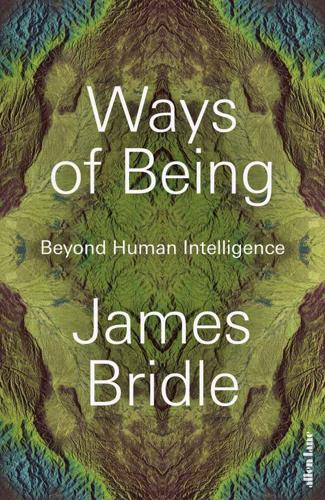
Ways of Being: Beyond Human Intelligence
by
James Bridle
Published 6 Apr 2022
By making the actual code of software and hardware accessible and legible to all, open-source practices decentralize knowledge and provide the basis for collective and self-education. The field of distributed computing is another example: it has given birth to both the extreme democracy of file-sharing and cryptocurrencies and to scientific initiatives like SETI@home and Folding@home. The former seeks to discover life in outer space, the latter to develop new cures to disease. Both use the power of remote processors provided by volunteers – the computers of the general public, linked by the internet – to churn through complex calculations which would overburden any single supercomputer.
…
(programming language) 161–2 open source 209 Operational Research Group 132 Optometrist Algorithm 211 Oracle (ancient Greece) 174, 213 oracle machine 177–8, 186, 193, 200, 202, 211, 223, 243 orang-utans 34–7, 35, 50, 162, 253 orcas 37 ostraka 217, 218 ostracism 216–17 Other Minds 50 Otto (gorilla) 45 Otto (octopus) 48 Overstory, The 61–2, 126, 271, 278, 283 Owens, Paul T. 168 oxen 142–3, 144 Pääbo, Svant 95–6 Pando (aspen) 77 paperclip hypothesis 6–7 Paquet, Paul 286–7 Parco Nazionale del Pollino see Pollino National Park Parnassus 21–3, 174, 204 Patterson, Francine 44, 45 Patty (elephant) 39 penguins 170 phenology 119 Phillips, Bill 206 phototaxis 180, 188, 212 Phyllantus balgooyi 310 Physarum polycephalum see slime mould Pickering, Andrew 184 Piet (programming language) 161 pigs 143, 252, 291 pines 115, 124, 138 plankton 59 Plotnik, Joshua 39 Pluie (wolf) 287–91, 296–7, 301, 305 Pollino National Park 138, 140, 142 pooh-pooh theory poplar 124 Post Office Research Station 220 Povinelli, Daniel 39 Power of Movement in Plants, The 127–8, 129 Powers, Richard 61–3, 126, 278, 283 prairie dogs 163 Pratchett, Terry 162 prepared piano 229 Project Cybersyn 214 pronghorn see antelope Pycnandra acuminata 310 quantum physics 84–6 Queer theory 208 radar 132–4, 285 radiolaria 239, 240, 242 radio telemetry see animal tracking randomness 241–5, 249, 301 computational 220–25, 227, 241 in evolution 227, 235–40 in music 227–35 lotteries 220 mathematical 219–20, 226 political appointment see sortition RAND Corporation 226, 275 Random.org 222 ravens 149, 164–5 Read, David 80 redwoods 59–61, 80, 109, 283, 312 Reid, Clement 124 Reiss, Diana 38–9 Repsol 4–6 reservoir computing 197 Richardson, Lewis Fry 101–2, 112 Roachbot 212, 212–13 Roah (raven) 164 Robinson, Kim Stanley 282 rock cress 65–6, 311 Roko’s Basilisk 273–5 rooks 118 sable 116 salmon 60 Sámi 115, 149–51 San Francisco Bay Model 202, 204, 207 Sand Talk: How Indigenous Thinking Can Save The World 172 Sardinia 148 Schultz, Jack 126 Secret Life of Plants, The 66 self-driving cars see autonomous vehicles SETI@home 209 Seven Bridges of Königsberg 81 Shanthi (elephant) 38 Shakespeare, William 152 sheep 140, 149, 302 Sheldrake, Merlin 78 Sid (octopus) 48 Silent Spring 12, 15 Silverman, Kenneth 229 Simard, Suzanne 59–63, 80, 283 slime mould 191–5, 191, 193, 198, 209, 211, 238–9, 248, 262, 312 sloths 108 Smuts, Barbara 52–5, 65 SMS 152–3 Snøhetta 294 Snowchange Cooperative 115 Socrates 174, 177, 213 soft robotics 197 solidarity 98, 151, 256–7, 274, 279–80, 296, 300 Somerset, James 264 Sophia (robot) 268–9, 272, 278 sortition 219, 243–8, 242, 247–8 Soul of a New Machine, The 117 sparrows 256 spruce 124–5 starlings 133 Stochastic Analogue Machine (SAM) 230–31 Stross, Charles 9 Superstudio 204, 204 Suzuki, D.
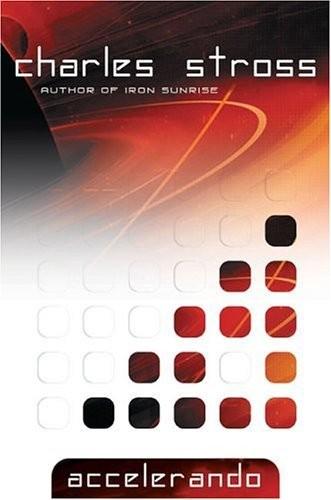
Accelerando
by
Stross, Charles
Published 22 Jan 2005
She reaches over for Boris's pitcher of jellyfish juice, but frowns as she does so: "Aineko wasn't conscious back then, but later … when SETI@home finally received that message back, oh, however many years ago, Aineko remembered the lobsters. And cracked it wide open while all the CETI teams were still thinking in terms of von Neumann architectures and concept-oriented programming. The message was a semantic net designed to mesh perfectly with the lobster broadcast all those years ago, and provide a high-level interface to a communications network we're going to visit." She squeezes Boris's fingertips. "SETI@home logged these coordinates as the origin of the transmission, even though the public word was that the message came from a whole lot farther away – they didn't want to risk a panic if people knew there were aliens on our cosmic doorstep.

C++ Concurrency in Action: Practical Multithreading
by
Anthony Williams
Published 1 Jan 2009
Scalability and Amdahl’s law Scalability is all about ensuring that your application can take advantage of additional processors in the system it’s running on. At one extreme you have a single-threaded application that’s completely unscalable; even if you add 100 processors to your system, the performance will remain unchanged. At the other extreme you have something like the SETI@Home[3] project, which is designed to take advantage of thousands of additional processors (in the form of individual computers added to the network by users) as they become available. 3http://setiathome.ssl.berkeley.edu/ For any given multithreaded program, the number of threads that are performing useful work will vary as the program runs.
…
The just::thread Implementation of the C++ Standard Thread Library, http://www.stdthread.co.uk. Message Passing Interface Forum, http://www.mpi-forum.org/ http://www.mpi-forum.org/. Multithreading API for C++0X—A Layered Approach, C++ Standards Committee Paper N2094, http://www.open-std.org/jtc1/sc22/wg21/docs/papers/2006/n2094.html. OpenMP, http://www.openmp.org/. SETI@Home, http://setiathome.ssl.berkeley.edu/. Index [SYMBOL][A][B][C][D][E][F][G][H][I][J][L][M][N][O][P][Q][R][S][T][U][V][W] SYMBOL #include <thread>, example of <atomic> header, reference <chrono> header reference <condition_variable> header reference <future> header reference <ratio> header reference <thread> header introduced std::thread class std::this_thread::get_id reference A ABA problem abstraction penalty ACE, and multithreaded code actor model Amdahl’s law serial fraction atomic integral types available operations return value of operations atomic operations enforcing ordering with memory ordering options atomic types, assignment operator, return type atomic variable, use as a done flag ATOMIC_ADDRESS_LOCK_FREE macro ATOMIC_BOOL_LOCK_FREE macros ATOMIC_CHAR_LOCK_FREE macro ATOMIC_CHAR16_T_LOCK_FREE macro ATOMIC_CHAR32_T_LOCK_FREE macro ATOMIC_FLAG_INIT macro ATOMIC_INT_LOCK_FREE macro ATOMIC_LLONG_LOCK_FREE macro ATOMIC_LONG_LOCK_FREE macro ATOMIC_SHORT_LOCK_FREE macro ATOMIC_VAR_INIT macro ATOMIC_WCHAR_T_LOCK_FREE macro auto keyword automatic type deduction and function template parameters deduction rules syntax B background threads bit-field, using to keep structure within machine word blocked thread blocking Boost, and multithreaded code boost::shared_mutex, 2nd bounded queue C C++ Standard overhaul support for multithreaded programs cache ping-pong, and performance callable type code reviews guidelines rubber chicken Communicating Sequential Processes actor model and lack of shared data compare-exchange functions.

Turing's Cathedral
by
George Dyson
Published 6 Mar 2012
The read/write privileges granted to digital codes already include material technology, human minds, and, increasingly, nucleotide synthesis and all the ensuing details of biology itself. The host planet would have to not only build radio telescopes and be actively listening for coded sequences, but also grant computational resources to signals if and when they arrived. The SETI@home network now links some five million terrestrial computers to a growing array of radio telescopes, delivering a collective 500 teraflops of fast Fourier transforms representing a cumulative two million years of processing time. Not a word (or even a picture) so far—as far as we know. Sixty-some years ago, biochemical organisms began to assemble digital computers.
…
Rosenberg, Jack, 7.1, 7.2, 8.1, 8.2, 8.3, 8.4, 18.1 and Julian Bigelow and Albert Einstein, 1.1, 18.1 on IBM on John von Neumann, 7.1, 10.1 on Klári von Neumann Rosenberg ground Rosenblueth, Arturo (1900–1970) Rosenbluth, Marshall (1927–2003), 10.1, 10.2, 11.1 Rosing, Boris (1869–1933) Rossby, Carl-Gustaf (1898–1957), 9.1, 9.2, 9.3 Rota, Gian-Carlo (1932–1999) Rotblat, Joseph (1908–2005) Rózycki, Jerzy Rubinoff, Morris (1928–2004), 7.1, 8.1, 8.2, 8.3, 14.1, 18.1 on Bigelow Russell, Bertrand Ryan, Meg SABRE (Semi-Automatic Business-Related Environment) Sachs, Judy SAGE (Semi-Automatic Ground Environment), 17.1, 18.1 Samuelson, Paul Santa Fe, New Mexico, 7.1, 10.1, 11.1, 11.2, 18.1 Sarnoff, David (1891–1971) Scherbius, Arthur Schlüsselzusatz (cryptographic machine) Schriever, Bernard Schwarzschild, Martin (1912–1997), 16.1, 18.1 on von Neumann, 4.1, 4.2 Scripps Institution of Oceanography, 11.1, 14.1, 18.1 SEAC (Standards Eastern Automatic Computer), 11.1, 15.1 search engines, 10.1, 13.1, 13.2, 14.1, 17.1, 17.2 as analog computers Selberg, Atle (1917–2007), 8.1, 12.1 Selberg, Hedvig (Hedi) Liebermann (1919–1995), 8.1, 8.2, 16.1, 18.1, 18.2 Selective Sequence Electronic Calculator (SSEC) Selectron, 5.1, 6.1, 8.1, 8.2, 8.3, 18.1, 18.2 and numerical weather prediction vs. Williams tube self-reproducing automata, 11.1, 11.2, 11.3, 15.1, 15.2, 15.3, 15.4 propagation of sequential analysis SETI@home set theory, 4.1, 6.1 Shannon, Claude Elwood (1916–2001), 1.1, 5.1, 7.1, 12.1, 15.1 shift registers, 6.1, 7.1, 8.1, 8.2 shock waves, prf.1, 4.1, 4.2, 12.1, 16.1, 16.2 signal vs. noise, 7.1, 7.2, 8.1, 9.1 SILLIAC (Sydney ILLIAC) Simon, Leslie E., 5.1, 5.2 Sims, John singularity, technological (von Neumann) 6J6 (vacuum tube), 7.1, 7.2, 8.1, 14.1 Slutz, Ralph (1917–2005), 7.1, 7.2, 7.3, 7.4, 7.5, 8.1, 8.2, 11.1, 18.1 Smagorinsky, Joseph (1924–2005), 9.1, 9.2, 9.3, 9.4, 18.1 Smagorinsky, Margaret, 9.1, 18.1 Small-Scale Experimental Machine, Manchester (SSEM), 8.1, 13.1 Smithsonian Institution Smyth, Henry D., 7.1, 18.1 Snyder, Richard L., 5.1, 18.1 social justice social networks, 14.1, 17.1 Society of Friends (Quakers), 2.1, 9.1 Sociological Complexity Theorem (Alfvén) software; see also stored-program computing; codes and coding solitaire Southwell, Sir Robert Soviet Union, 6.1, 10.1, 11.1 and nuclear weapons, 1.1, 1.2 Special Engineering Detachment (SED, U.S.
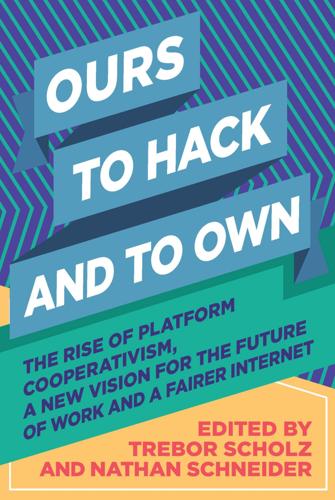
Ours to Hack and to Own: The Rise of Platform Cooperativism, a New Vision for the Future of Work and a Fairer Internet
by
Trebor Scholz
and
Nathan Schneider
Published 14 Aug 2017
Transaction costs associated with both market exchanges and social sharing have declined; interactions once preserved for firms that combined capital with contractual commitments for labor, materials, and distribution can now be done in a more distributed form. This technological fact has underwritten the rise of the on-demand economy, workforce management software that increases contingency, and outsourcing and offshoring no less than it underwrote FOSS, Wikipedia, or SETI@home. It will not determine a more cooperative future, but it does mitigate some of the most important barriers that historically hampered cooperativism. Uber and Airbnb both involve the reallocation, through markets, of shareable goods: mid-grained lumpy goods, put in service by people for their own use, but with excess capacity.
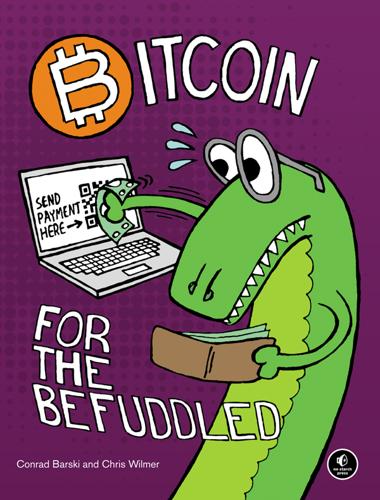
Bitcoin for the Befuddled
by
Conrad Barski
Published 13 Nov 2014
Figure 6-1: Photographs of the pizzas purchased by laszlo for 10,000 bitcoins in May 2010 (left) and the 2014 Lamborghini Gallardo purchased for 216 bitcoins in December 2013 Bitcoin’s Early Impact Although Bitcoin is still a very new technology, we can already point to several notable achievements, not only in computer science but also in economics and politics. It Is the Largest Distributed Computing Project in History Less than three years after its inception, Bitcoin had already eclipsed famous distributed computing projects, such as SETI@home, in terms of total computing power.6 Two years later, that computing power had further grown by a thousand times. By April 2014, if you combined the strength of the world’s top 500 supercomputers, the result would be a computer less than 0.05 percent as powerful as the Bitcoin network. This incredible growth, particularly in recent years, was made possible by the large-scale manufacturing of special-purpose computer chips designed solely for Bitcoin mining.

Whiplash: How to Survive Our Faster Future
by
Joi Ito
and
Jeff Howe
Published 6 Dec 2016
Specifically, the best-known algorithms used today are practically infeasible for very large numbers, hence the bigger the number the less likely a computer is to factorize it in a reasonable time frame. The first public message encrypted with RSA used a relatively small value of N—only 129 digits. It still took seventeen years before a team of six hundred volunteers donating their spare processor cycles, in the way of SETI@Home, cracked the code. Of course, a day may come when mathematicians discover an easier way to factor large numbers, and the day will come when RSA cannot produce a large enough key to make it secure against the world’s most powerful computer networks. We have come a long way from Caesar’s cipher, but even today we rely on the dubious notion that the key, the secret that allows us to decrypt a message, can be kept secure and private—that we have the strength to protect our secrets.
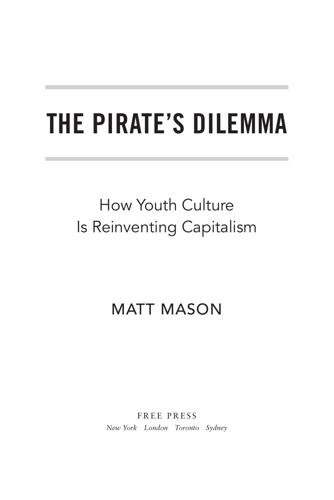
The Pirate's Dilemma: How Youth Culture Is Reinventing Capitalism
by
Matt Mason
Community computing is a way to create vast amounts of decentralized computer power by connecting home computers together like Voltron, using their spare disk space to do massive calculations and process vast swathes of data that no single supercomputer could handle. By signing up online to services such as SETI@home, which processes radio frequencies from outer space (SETI stands for the search for extra terrestrial intelligence), instead of just going on standby, your laptop joins more than five million other PCs linked together to search for flying saucers whenever you're not using it. [FN: Maybe SETI should look in the museum at Fort Eustis, Virginia, or the Smithsonian Air and Space Museum in Maryland, where there still exist two prototype flying saucers that were built by the U.S.

The Big Nine: How the Tech Titans and Their Thinking Machines Could Warp Humanity
by
Amy Webb
Published 5 Mar 2019
In 2002, researchers at the Berkeley Open Infrastructure for Network Computing figured out that if some of us allowed our devices to be hijacked while we sleep, it might be possible to simulate the power of a supercomputer—and that power could be put to scientific use. Early experiments proved successful as hundreds of thousands of people donated their idle processing time to all kinds of worthy projects around the world, supporting projects like the Quake-Catcher Network, which looks for seismic activity, and SETI@home, which searches for extraterrestrial life out in the universe. By 2018, some clever entrepreneurs had figured out how to repurpose those networks for the gig economy v2.0. Rather than driving for Uber or Lyft, freelancers could install “gigware” to earn money for idle time. The latest gigware lets third-party businesses use our devices in exchange for credits or real money we can spend elsewhere.
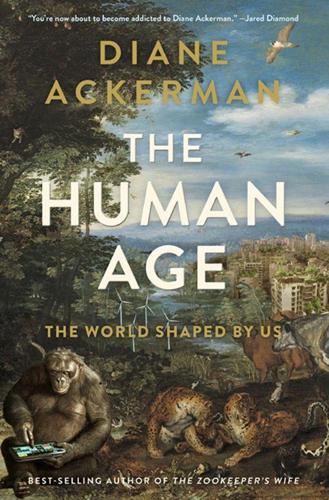
The Human Age: The World Shaped by Us
by
Diane Ackerman
Published 9 Sep 2014
But now they and the Dalai Lama (a science aficionado) are also aware, from mindful moment to moment, of an invisible dimension that includes neurons, quarks, Higgs bosons, MRIs, condensation nuclei, white dwarfs, DNA, and a googolplex of others. Elsewhere on Earth, over 5.2 million Internet-connected computers, citizen scientists are helping SETI (Search for Extraterrestrial Intelligence) monitor radio telescope data through the SETI@home project, hoping to catch a message from alien life forms in some distant star system. SETI’s senior astronomer, Seth Shostak, believes that the first calling card from aliens may well be detected on home computers, not by official scientists at radio telescopes arrayed in India, Australia, Puerto Rico, or Chile.
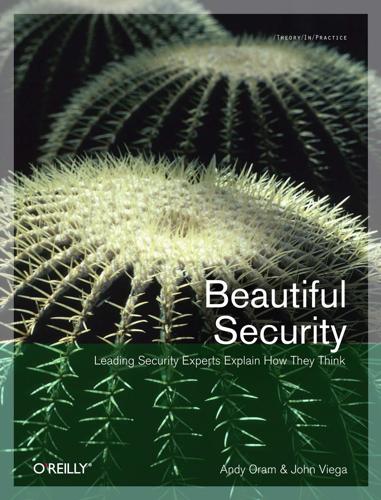
Beautiful security
by
Andy Oram
and
John Viega
Published 15 Dec 2009
OPEN SOURCE HONEYCLIENT: PROACTIVE DETECTION OF CLIENT-SIDE EXPLOITS 145 The Future of Honeyclients There are over 240 million websites on the Internet today (and of course the number keeps growing by leaps and bounds), and there’s not one group that can cover all of those websites with honeyclient technology. To better fight these attackers that damage our machines and steal our data, we need to band together and learn from each other. We should envision a future where honeyclients take a SETI@home (“Search for Extraterrestrial Intelligence at home”) approach, in which each honeyclient is able to process its own data and send it back to a central database repository that can more effectively correlate the data. This can help us identify targeted domains: for example, if company A’s employees are being targeted by company B in order to compromise someone’s computer and steal corporate documents.

Space Chronicles: Facing the Ultimate Frontier
by
Neil Degrasse Tyson
and
Avis Lang
Published 27 Feb 2012
These are the civilizations that would be more likely to do the sending. The search for extraterrestrial intelligence (affectionately known by its acronym, SETI) has taken many forms. Long-established efforts have relied on monitoring billions of radio channels in search of a radio or microwave signal that might rise above the cosmic noise. The SETI@home screensaver—downloaded by millions of people around the world—enabled a home computer to analyze small chunks of the huge quantities of data collected by the radio telescope at Arecibo Observatory, Puerto Rico. This gigantic “distributed computing” project (the largest in the world) actively tapped the computing power of Internet-connected PCs that would otherwise have been doing nothing while their owners went to the bathroom.
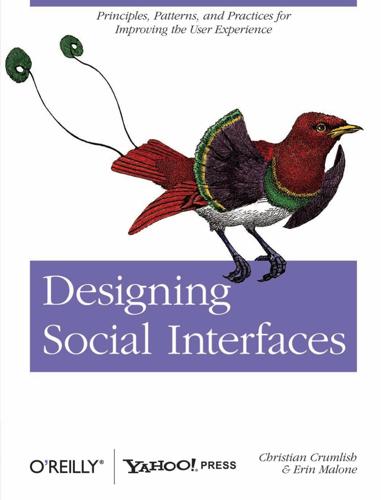
Designing Social Interfaces
by
Christian Crumlish
and
Erin Malone
Published 30 Sep 2009
Why Crowdsourcing breaks large jobs into pieces that can be tackled with a much lower commitment threshold, taking advantage of the loose ties in social networks. As seen on Amazon Mechanical Turk (http://www.mturk.com/mturk/welcome) Assignment Zero (http://zero.newassignment.net/) The ESP Game (http://www.cs.cmu.edu/~biglou/ESP.pdf) iStockphoto (http://istockphoto.com) ReCAPTCHA (http://recaptcha.net/) SETI@home (http://setiathome.ssl.berkeley.edu/) Threadless (http://threadless.com) Download at WoweBook.Com 330 Chapter 12: Barnraising Further Reading “Berners-Lee on the read/write web,” BBC News, August 9, 2005, http://news.bbc.co.uk/2/ hi/technology/4132752.stm Cross Cultural Collaboration, http://crossculturalcollaboration.pbwiki.com/ “Deriving Process-driven Collaborative Editing Pattern from Collaborative Learning Flow Patterns,” by Olivera Marjanovic, Hala Skaf-Molli, Pascal Molli, and Claude Godart, http://www.ifets.info/journals/10_1/12.pdf “Edit This Page,” by Dave Winer, http://www.scripting.com/davenet/1999/05/24/editThisPage.html Edit This Page PHP, http://sourceforge.net/projects/editthispagephp/ Paylancers blog, http://paylancers.blogspot.com/ The Power of Many, http://thepowerofmany.com Regulating Prominence: A Design Pattern for Co-Located Collaboration (http://www.ida.liu.se/~matar/coop04arvola-web.pdf) “The Rise of Crowdsourcing,” by Jeff Howe, Wired 14.06, http://www.wired.com/wired/archive/14.06/crowds.html “The Simplest Thing That Could Possibly Work,” by Bill Venners, http://www.artima.com/intv/simplest.html Universal Edit Button, http://universaleditbutton.org/Universal_Edit_Button Wiki Design Principles, http://c2.com/cgi/wiki?
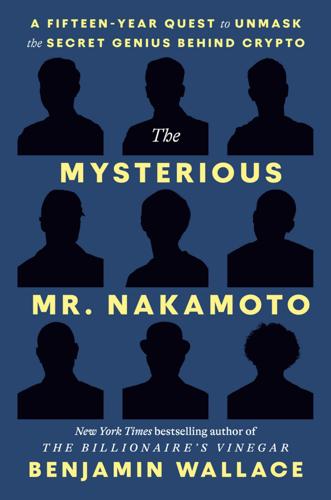
The Mysterious Mr. Nakamoto: A Fifteen-Year Quest to Unmask the Secret Genius Behind Crypto
by
Benjamin Wallace
Published 18 Mar 2025
A typically atypical example was Dustin Trammell, who went by Druid online. Dustin was a thirty-year-old hacker who liked to learn by participating; away from his computer, he was a cosplay enthusiast. He’d dabbled in metal-backed alt-currencies, such as one called the Liberty Dollar, and donated his computers’ spare processing cycles to SETI@home, a long-running UC Berkeley experiment in crowdsourcing analysis of radio-telescope data as part of a search for extraterrestrial intelligence. After learning about Bitcoin, Dustin diverted half of those computers to run its software, just because he saw it as a cool tech project. Later, he’d become interested in libertarian monetary ideas.
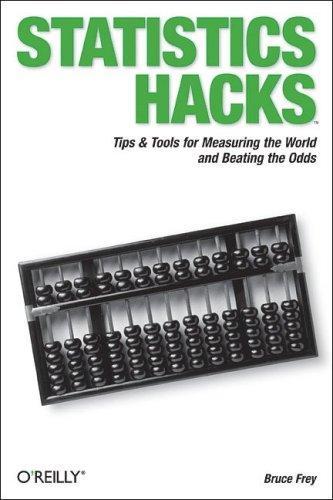
Statistics hacks
by
Bruce Frey
Published 9 May 2006
Statisticians would refer to this situation as a study that needs a great deal of power [Hack #8] because the effect size is so small. There is so much data being collected as part of systematic efforts to scan the skies, no one person or even one computer can possibly analyze it all. You can help! SETI@home is a Berkeley University-based program that arranges for regular people with regular home or office computers to receive some of this data, so their computers can analyze it when they're not doing something else. SETI is the acronym for Search for Extraterrestrial Intelligence. The program works like a screensaver and can be downloaded for free at http://setiathome.berkely.edu.

Hacker, Hoaxer, Whistleblower, Spy: The Story of Anonymous
by
Gabriella Coleman
Published 4 Nov 2014
A typical scenario might see a herder tabbing back and forth between regular chat channels and the hidden C&C channel as it grows more powerful by the moment. A typical botnet might boast around twenty thousand computers, but larger botnets have been tracked to upwards of thirty million. (Though most botnets have a bad rap—and for good reason—some botnets are voluntary and participatory. The most famous of these is probably SETI@home, the three-million-strong string of computers searching for alien life in outer space.) They hover on this C&C channel until the botnet herder gives them an order—usually authenticated—to perform some task. So for example, the botnet herder might simply say, “ddos 172.16.44.1” and then all the connected bots will begin to attack that specified IP address.10 Another common task for botnets is to send mass amounts of unwanted email.
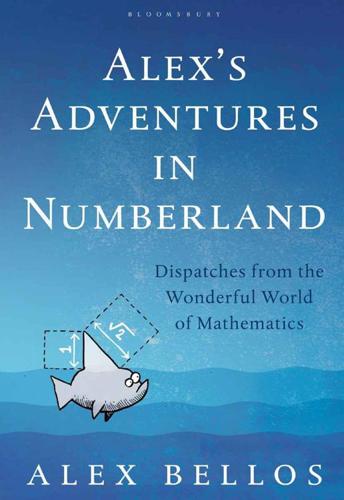
Alex's Adventures in Numberland
by
Alex Bellos
Published 3 Apr 2011
The Great Internet Mersenne Prime Search, or GIMPS, currently links about 75,000 computers. Some of these are in academic institutions, some are in businesses and some are personal laptops. GIMPS was one of the first ‘distributed computing’ projects and has been one of the most successful. (The largest similar project, Seti@home, is deciphering cosmic noise for signs of extraterrestrial life. It claims three million users but, so far, has discovered nothing.) Only a few months after GIMPS went online a 29-year-old French programmer netted the 35th Mersenne prime: 21398269 – 1. Since then, GIMPS has revealed another 11 Mersenne primes, which is an average of about one a year.
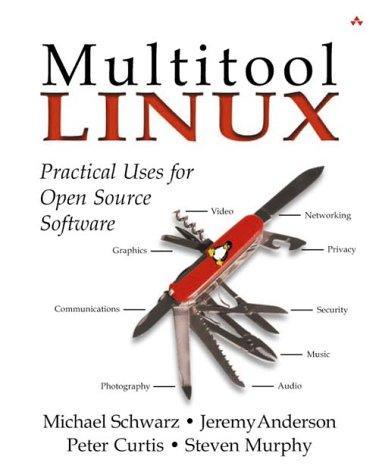
Multitool Linux: Practical Uses for Open Source Software
by
Michael Schwarz
,
Jeremy Anderson
and
Peter Curtis
Published 7 May 2002
What I needed was a way to keep my home system offline until I needed it and then have it go online and stay that way until I told it to disconnect. Some time ago I decided to make it so my system would periodically connect to the Internet and download e-mail from my ISP using a nifty program called Fetchmail. I wrote a few Perl scripts to automate and synchronize the connection requests from various applications, like SETI@Home and Fetchmail, which both need to connect to the Internet at various times. Plus, I needed to go online to surf around but not get disconnected when the Fetchmail utility was complete. Getting e-mail with Fetchmail allows me to spend as little connection time as possible getting and responding to e-mail.